










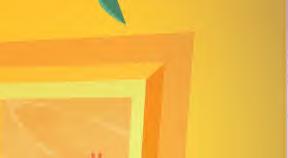






































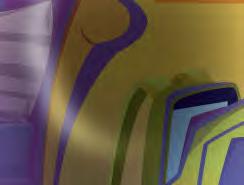




























































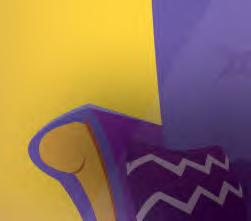


























































JUNIOR 4 Teacher’s Book DIGITAL SAMPLE
Your course comes with a Student’s eBook and digital resources on the Pearson English Portal.
To access the Pearson English Portal and eBook:
1 Go to pearsonenglish.com/login
2 Sign in or create an account.
3 Once signed in, follow the on-screen instructions to add a product and use the access code below
This code can only be used once.
Need help?
Go to MyPearsonHelp.com/portal for help, training and technical support.
Teacher’s Edition













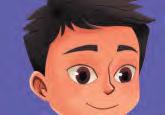




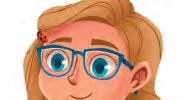





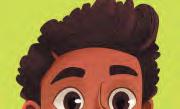








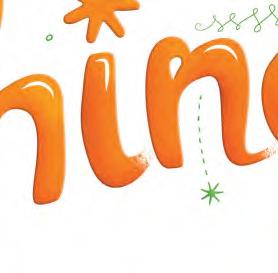
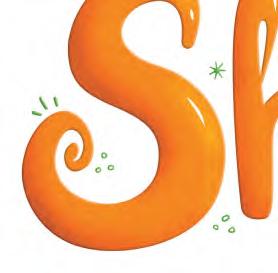

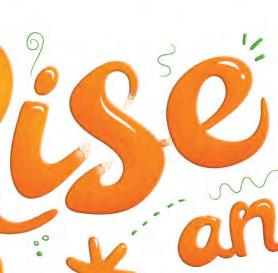
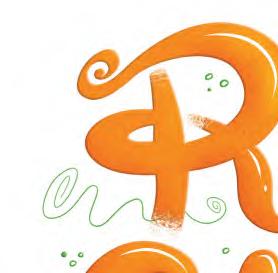 Alicia
Daniel Thomas Rafa Lena
Alicia
Daniel Thomas Rafa Lena
3
Pearson Education Limited
KAO Two
KAO Park
Hockham Way Harlow, Essex CM17 9SR England and Associated Companies throughout the world.
pearsonenglish.com
© Pearson Education Limited 2022
All rights reserved; no part of this publication may be reproduced, stored in a retrieval system, or transmitted in any form or by any means, electronic, mechanical, photocopying, recording, or otherwise without the prior written permission of the Publishers.
First published 2022
Set in Mark OT Pro Book Student’s Book pages set in Daytona Pro Primary)
Acknowledgements
The publishers and authors would like to thank James Laidler (Educational Consultant) for his feedback during the development of the material and invaluable knowledge and guidance on the Managing inclusive classrooms section of the book. The publisher would like to thank the following for their kind permission to reproduce their images: Video screen shots
By ITN Productions
Course character artwork (including cover) Illustrated by BluBlu Studios
All other images © Pearson Education https://www.un.org/sustainabledevelopment/ The content of this publication has not been approved by the United Nations and does not reflect the views of the United Nations or its officials or Member States.
Student’s Book Acknowledgements
The publisher would like to thank the following for their kind permission to reproduce their photographs:
(Key: b-bottom c-centre l-left r-right t-top)
123RF.com: Anna Grigorjeva 14, belchonock 89, Craig Robinson 71, Richard Thomas 21, Wavebreak Media Ltd 14; Alamy Stock Photo: Encore 15, 19, Geopix 88, graficart.net 24, Heather Drake 26, imageBROKER 58, IndiaPicture 38, Kirk Fisher 93, NordicImages 15, robertharding 27, Shotshop GmbH 54, Stephen French 89, SuperStock 38, Taina Sohlman 15, View Stock 16, Westend61 GmbH 49, Xinhua 38; Getty Images: 81a/Photolibrary 8, ALEAIMAGE 88, andresr 36, Andrew Bret Wallis 60, Ariel Skelley 24, artisteer 42, baona 89, Bruno Guerreiro 62, Camille Tokerud 71, creativesunday2016 5, dcdebs 61, Dennis Glosik/500px 62, elenaleonova 19, Fuse 54, Gallo Images 58, gbh007 27, GlobalStock 46, jacobeukman 58, jez_bennett 60, JGI/Jamie Grill 61, Johner Images 70, JohnnyGreig 17, Jose Luis Pelaez Inc 27, 91, kali9 27, katoosha 38, Keren Su 62, Lane Oatey/Blue Jean Images 16, Londolozi Images/Mint Images 63, Maica 91, Maskot 26, 89,
Miguel Sanz 63, Mirrorimage-NL 43, monkeybusinessimages 89, NickyBlade 21, Nirad 77, orangelinemedia 91, Patrik Giardino 46, PeopleImages 90, photoquest7 24, Pitipat Usanakornkul/ EyeEm 36, princessdlaf 8, Richard Drury 71, Skip Brown 70, SolStock 46, Stephan Jaggy/500px 62, Stockbyte 27, 92, Tim Hall 71, unclepodger 11, ValuaVitaly 27, viafilms 19, webguzs 60, Westend61 68, 68, ziggy_mars 46, Zoran Kolundzija 61; Pearson Education Ltd: Jon Barlow 9, 15, 19, 25, 29, 36, 37, 41, 47, 49, 51, 59, 63, 69, 73, 88, 89, 90, 91, 92, 93, Studio 8 91, Terry Leung 49, Trevor Clifford 8; Shutterstock.com: 8, 24, Alexandr Shevchenko 88, BCFC 88, Becky Wass 70, Bobkeenan Photography 64, cowardlion 16, 16, doomu 7, Dragon Images 48, Edge Digital Imaging 19, Elena Elisseeva 15, esthermm 14, FamVeld 68, Fotofermer 77, fotosaga 49, Hung Chung Chih 58, inaina 16, Jack N. Mohr 65, Jeanette Virginia Goh 48, John Abbate 32, Paul Vinten 60, Petr Bonek 70, Pressmaster 36, RedKoala 69, Roman Gorielov 32, Spotmatik Ltd 68, Syda Productions 26, Tatyano O 48, Toms Auzins 26, Tramont_ana 76, travellifestyle 88, VaLiza 26
Cover Images: Front: 123RF.com: Gabriel Murad; Alamy Stock Photo: View Stock
All other images © Pearson Education
Illustrated by BluBlu Studios (main character artwork); Emma Allen /Sylvie Poggio: pp. 6, 12, 22, 34, 44, 56, 66; Valentina Bandera /Sylvie Poggio: pp. 9, 28, 40, 72;Ruth Bennett /The Bright Agency pp: 82-87; Lyn Dylan /Sylvie Poggio: pp. 15 (Ex 1), 25 (Ex 1), 37 (Ex 1), 47 (Ex 1), 59 (Ex 1); Jen Naalchigar /The Bright Agency: pp. 61; Hyphen SA (Zacharias Papadopoulos); Elisa Rocchi / Beehive Illustration: pp. 78-81; Simona Rossi /Sylvie Poggio: pp. 30, 52, 74; Ana Sebastian /The Bright Agency: pp. 15, 25, 37, 47, 59, 69 pronunciation; Skylar White /The Bright Agency: pp. 8, 27, 39.
Dados Internacionais de Catalogação na Publicação (CIP) (Câmara Brasileira do Livro, SP, Brasil)
Rise & Shine in English : teacher's book : vol. 3 : PES grade 3. -- São Paulo : Pearson Education do Brasil, 2022. -- (Rise & Shine PES ; 3) ISBN 978-65-5770-479-0
1. Inglês - Estudo e ensino I. Série.
22-103152 CDD-420.7
Índices para catálogo sistemático:
1. Inglês : Estudo e ensino 420.7
Eliete Marques da Silva - Bibliotecária - CRB-8/9380
Contents
Course overview
Scope and sequence 4

Introduction 6 Using Rise and Shine 8
Component overview 10 Course methodology

Skills development in Rise and Shine 12 Future skills 13 Unit walkthrough 15 Measuring progress in Rise and Shine 18
Practical tips and planning
Managing inclusive classrooms 21
Teaching with video 22
Facilitating speaking 23
Teaching with posters 24
Classroom management 25 Games and extensions 26
Classroom language 28 Course planning 29
Teaching notes and scripts
Teaching notes 30
Workbook 3 audio script 172 Our World video scripts 175
Scope and sequence
Welcome to Rise and Shine Library
1 All about school!
Numbers 20–50; places in a library: courtyard, gallery, information desk, multimedia room, reading corner, study area
School subjects: art, drama, English, geography, history, technology, math, music, P.E., science
The (library) has/ doesn’t have (a gallery).
What do you have on (Monday)? I have (art) and (geography) on (Monday).
2 Explore our town!
Review 1

All about us (Unit 1 and 2)
3 Let’s tell stories!
4 Party at the library!
Review 2 Our community (Unit 3 and 4)
5 Let’s save our animals!
Places in a town: bus stop, cafe, drugstore, grocery store, hospital, movie theater, police station, sports center, store, town square
Book characters: astronaut, inventor, villain, explorer, pirate, prince, princess, spy, storyteller, superhero
Hobbies: acting, coding, having a party, juggling, learning an instrument, painting, playing chess, playing video games, taking pictures, trading cards
Animals: leopards, lions, monkeys, pandas, parrots, penguins, rhinos, snakes, tigers, zebras
There are some (stores). There aren’t any (schools).
Items in a library: beanbag, computer, poster, TV
Routine actions: brush my teeth, go to bed, go to school, have breakfast, take a shower, wake up
Jobs: bus driver, doctor, librarian, police officer, sales clerk, server
Does the (library) have (computers)? Yes, it does./No, it doesn’t.
What time do you (wake up)? I (wake up) at (seven o’clock).
Is there a… ? Yes, there is./No, there isn’t.
Are there any… ? Yes, there are./No, there aren’t.
The book is about (a villain). Is she (happy)? Yes, she is./No, she isn’t.
She likes (taking pictures). He doesn’t like (playing chess).
Adjectives: brave, cute, kind, scary, smart, strong
Are they (smart)? Yes, they are./ No, they aren’t.
Activities: being outside, doing crafts, helping people, learning something new, playing sports, using computers
Does he/she like (being outside)? Yes, he/she does./No, he/ she doesn’t.
Tigers can/can’t (run). Can they (fly)? Yes, they can./No, they can’t.
Animal parts: feathers, fur, spots, stripes, tail, wings
6 Come on an adventure!
Review 3
Our world (Unit 5 and 6)
Goodbye
Celebrations
Vacation activities: building a fort, drawing, fishing, having a picnic, hiking a nature trail, reading a map, riding a bike, rock-climbing, sailing, skateboarding
He/she’s (fishing). He/she isn’t (riding a bike).
Have a great summer! See you soon!
Places in nature: country, forest, island, lake, mountain, river
They have/don’t have (fur). Do they have (spots)? Yes, they do./ No, they don’t.
What’s he/she doing? He’s/She’s (skateboarding). Is she (riding a bike)? Yes, she is./No, she isn’t.
World Teachers’ Day: cafeteria, classroom, computer lab, gym, music room, science lab
World Kindness Day: care about someone, give someone a gift, help someone, say thank you, smile, talk to a friend
World Book Day: costume, dress up, inventor, king, queen, tell a story
World Environment Day: grow vegetables, plant trees, recycle, turn off lights, walk to school, water the plants
2
Vocabulary 1 Grammar 1Vocabulary 2Grammar
Course overview 4
PronunciationFunctional languageGlobal citizenship
Telling the time
What time is it? It’s (one o’clock/one-thirty).
/ɔɪ/ boy, /ɒːk/ walk
Asking and answering about travel to school How do you go to school? I go (to school) by (bus)./ I walk (to school).
/er/ there, /ɑːr/ park
Talking about where you live
Where do you live? I live on (Park Street).
/b/ book, /v/ brave
Giving opinions, agreeing and disagreeing: I think this book is great. So do I./Oh, I do.
/ɜːr/ girl, /ɪŋ/ things
Talking about what you’re good at Are you good at (coding)? Yes, I am./No, I’m not. I want to learn
/s/ snake, /ʃ/ she
Making and responding to suggestions
Let’s (watch a movie). I’m not sure./Yes, that sounds great!
/ər/ weather, /oʊ/ snow
Talking about the weather What’s the weather like today? It’s cloudy/rainy/ snowy/sunny/windy.
Real-world writing Project
I appreciate community spaces.A library record
I appreciate different school days. classroom, homework, playground, schedule
Learning to learn, being curious and motivated to learn something new.
I learn about different towns. bench, community, fountain, friendly Participate in community activities and enjoy community spaces.
I enjoy storytelling. beautiful, exciting, fun, interesting
Have interest in and enjoy books and stories.
I learn new hobbies and crafts. cut, fold, knit, stick Understand the importance of trying new things.
A diary entry A photo diary
I appreciate animal habitats. desert, grassland, jungle, ocean Appreciate the importance of animals for our planet and how we can coexist.
I enjoy activities outside. kayaking, skiing, sledding, windsurfing
How to have an adventure close to home, stay active, and enjoy being outside.
A leaflet A town map
Future skills
Future skills 1: Encouraging others
Future skills 2: Community spaces
Future skills 3: Listening
A book review A story character
Instructions A new hobby
An animal fact sheet An animal project
A blog post An adventure park ad
Future skills 4: Learning to learn
Future skills 5: Making decisions
Future skills 6: Problem solving
Course overview 5
Introduction
Rise and Shine is a six-level elementary school course that develops language alongside global citizenship and future skills. Fun characters, relatable stories, and real-life videos support clear, child-friendly learning objectives that motivate students on their English-learning journey. Clear, structured lessons build to a final unit project and offer real opportunities to achieve, track, and measure progress, encouraging students to think about and take ownership of their own learning.

Rise and Shine provides a unique toolkit to support teachers in identifying and addressing the needs of every student. Clear, measurable outcomes that students can see and celebrate motivate them to engage with the new experience of language learning. Targeted support and achievable activities mean that every student has a chance to thrive and teachers can address challenges such as mixed ability and special educational needs.
Course principles


A sense of purpose
Rise and Shine has been designed with deliberate progress in mind. Every activity and lesson builds towards a clear objective and a final unit project that gives every student their Time to shine. Structured lessons support students in acquiring the knowledge, language, and tools they need as they work towards their Time to shine
A step-by-step approach








Rise and Shine builds confidence in using English through a learning cycle of exposure, recognition, controlled practice, and freer practice. Each activity is designed to support students to build on what they have already learned and work towards a clear task at the end of each stage of the unit. The I can shine box consolidates the learning of each stage into an activity explicitly linked to the learning objective. This gives students the opportunity to pause and reflect on how confident they feel with the material in an age-appropriate way. These activities build to the final Time to shine task at the end of the unit, where students are supported through the steps to create and present a project of their own.
Clear progress and accessible learning outcomes
Rise and Shine is built on the Global Scale of English, which helps students understand exactly what they are learning and why. It is designed so that students are always aware of their learning goals for the unit and are able to chart their progress at the end of each stage of the unit through a clear I can shine activity.
Each unit of Rise and Shine follows five stages, each comprising one or two lessons. The stages are clear to students and support them in understanding exactly how far they have come and where they are heading on their learning journey. This learning journey is signposted to students by colored stepping stones in the Student Book.


activities that spark interest, draw on prior knowledge, and set out the quest for the unit
imaginative stories and activities that encourage cognitive engagement





meaningful language input and practice, providing direction and support, with a strong focus on building communication skills and confidence real-world content that opens students’ eyes through a global citizenship objective and provides opportunities to relate language back to their own lives

a final unit project broken down into differentiated steps to allow every student to showcase their achievements

Rise and Shine is also designed for use in inclusive and mixed-ability classrooms. It helps all students achieve their learning goals, while recognizing that this will look different for different students. Activities and lessons are structured to be increasingly challenging to allow all students to achieve.
Rise and Shine recognizes that teachers need their time to shine, too! Ideas to support and stretch individual students are offered in each lesson, alongside clear teaching notes divided by lesson stage. Each I can shine activity is supported by a framework of Achieve, Adjust, Exceed to empower teachers to assess progress at each stage of the unit.
Development of future skills and global citizenship





English is more than just a school subject in the 21st century – it is a medium through which children learn about life, and global and local issues that are relevant to them. Rise and Shine supports and guides students on their own learning journey through dedicated helpers in each stage of the unit. Just like the characters in their favorite adventure stories, students face exciting tasks that help them build a greater understanding of themselves and the world around them, all the while working towards clear learning goals.

6
Wonder Imagine Build Grow Shine Course overview Time to shine! 9 Present your photo diary to the class. 10 What’s your favorite school day? I can talk about my school days.
I wake up at six-thirty. I have breakfast at seven o’clock. We have geography, P.E., and history on Thursday.
Welcome to Rise and Shine Library!



















Each level of Rise and Shine takes place in a different setting that is relatable to students but offers opportunities to explore. Level 3 takes place in Rise and Shine Library, where we meet the following main characters: Daniel, Alicia, Lena, Rafa, Thomas, and Biscuit the cat. Students will relate to the importance of the local neighborhood and how so much of the characters’ lives centers on family, friends, and neighbors, preparing them for future life skills.
























































7
Course overview
Using Rise and Shine
Vocabulary and structures
Vocabulary in Rise and Shine has been carefully selected to be relevant to students and their lives and is presented in logical topic sets. Key vocabulary is always presented using the course characters to provide students with a familiar context for the new language. Lesson 1 presents ten key vocabulary items while an additional six key items are presented in Lesson 3. Vocabulary lessons always offer opportunities for students to reflect and share what they already know on the topic, before clear presentation and practice stages. The Workbook provides additional vocabulary practice. The Word connections list at the end of the Workbook can be used to consolidate the vocabulary of each unit. In addition to the key vocabulary, four related vocabulary items are presented in Lesson 6 as part of global citizenship.
In Level 3, grammar structures are taught in simple chunks that young students are able to grasp more easily than complex grammar rules. New structures are presented through a song or chant in Lessons 2 and 4. New language is clearly highlighted in boxes on the Student Book page, which provide a reference point for students as they learn and practice.
Every lesson includes opportunities for students to recycle language from previous lessons and units. New language is never presented in isolation but in the context of what students have already learned, so that they are more likely to retain it.
Skills
Rise and Shine systematically develops the four skills through a stepped approach clearly defined in the lesson flow. Each skill is developed independently in the early part of the unit, before being brought together with an integrated skills approach in the Grow stage. Learning objectives covered in Rise and Shine have been specifically selected to help students at this level develop skills in a structured way. Special emphasis is put on communication, with a dedicated lesson in the Build stage to develop spoken communication skills and confidence. For more detailed information on how skills are developed in Rise and Shine, see page 12.
Global citizenship
A dedicated global citizenship lesson provides opportunities for students to explore the wider world by bringing real world content into the classroom. Each unit has a different global citizenship focus that encourages students to think about global and local contexts, with emphasis on cultural awareness, empathy with local and global issues, and socialemotional skills development. For more information on global citizenship, see page 13.
Real-world links
Rise and Shine is story-based and each level revolves around the community-based adventures of a set of characters. The stories and settings have been carefully chosen to be interesting and perhaps slightly unusual to students, while still being firmly rooted in reality. The result is characters and stories students can fully relate to but that are exciting enough to capture and keep their attention. Real-world links are further reinforced through dedicated functional language lessons, beautiful pictures, global citizenship themes, and videos.
Projects
Every unit in Rise and Shine builds up to a final project that gives every student their Time to shine. As students move through the unit, they collect the language, knowledge, and skills they need to complete a final task that provides the opportunity for students to apply everything they have learned. Projects are broken down into achievable steps, so that every student can achieve at the appropriate level of challenge. For more information on projects, see page 20.
Inclusive classroom
Rise and Shine is especially developed to support every student to achieve. Assessment for Learning methodology and personalized activities support all students, with opportunities for extra support and stretch embedded into the lessons. Teachers are provided with clear guidance and targeted support in formative assessment activities, as well as tips and tricks throughout the course. For more information on managing inclusive classrooms, see page 21.
Assessment
Rise and Shine offers comprehensive in-course assessment to measure students’ mastery of the language and skills taught in the Student Books in relation to specific learning outcomes. A Diagnostic test helps teachers check previous learning and identify any areas for particular attention throughout the year. Dedicated activities in the Student Book provide opportunities for informal assessment at every stage of the unit, while Unit tests provide a more formal assessment of the unit objectives. Review lessons and cumulative Progress Review tests every two units enable teachers to check progress regularly against the key learning outcomes for the level. The final End-of-Year test offers a more formal evaluation of the year’s learning. For more detailed information on how to assess student performance, see pages 18 and 19.
8
Course overview
Motivation

Keeping young students motivated and on task in the classroom can be a challenge, especially in large and/or mixed-ability groups. Rise and Shine supports teachers by providing:
• a wide variety of purposeful activities, so students never feel that they are doing the same activity types over and over,



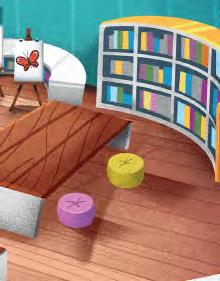

• fun contexts that students can relate to,
• age-appropriate real-world content,
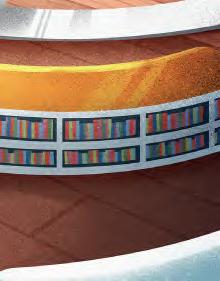


• stories, songs, games, and projects that provide plenty of fun,


• a lot of opportunities for students to communicate about themselves and their own lives,


• clear goals and opportunities for reflection with story character “helpers,”

• activities that build confidence and a sense of achievement for every student.

9
Course overview
Component overview






























For students

Student Book and eBook




The Student Book provides material to present and practice the key language effectively. It is divided into six core units, a Welcome unit, a Goodbye lesson, four Celebrations lessons, six Future skills lessons, and six Grammar lessons.
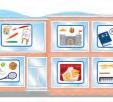


Workbook and eBook












Workbook provides reinforcement and consolidation of the language and skills presented in the Student Book. It contains practice for every lesson in the Student Book and a Word connections list to support students in reviewing and remembering key vocabulary.



Busy Book
The Busy Book provides further practice of key language in a fun and engaging format. Activities are structured in such a way that students can work on them independently. It is a flexible component that can be used for whole-class work, in class for fast finishers, or at home.
and the























Rise and Shine on the Pearson English Portal




Students can access extra activities online on the Pearson English Portal. Here, they can complete assigned homework and check their progress, play extra games, listen to the course songs, and watch the course videos.
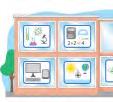



10
Library All about
10 11 I can shine! 2 7 10 1 6 4 3 8 9 5 Lesson What can you see? 1 Listen and find. 2 1.02 Listen and point. Then listen and say. Lesson 2 1 Read and sing. 2 1.06 Listen and circle true (T) or false (F). 1 T / F 2 T F 3 T / F 4 T / F 3 What do you have on Monday? Say. 3 Watch and listen. 4 1.03 Listen and say. Then play. 4 Ask and answer. Vocabulary School subjects Song and structures What do you have on (Monday)? I have (art) and (geography) on (Monday) Say what I have at school each day. Read about subjects and daily routines. Say how go to school. Write a diary entry. Create a photo diary. can say what I have at school each day. Wonder Every day I go to school, School is fun! School is cool! What do you have on Monday? On Monday at school? I have math and geography! What about you? Chorus What do you have on Tuesday? On Tuesday at school? I have art and music! What about you? Chorus What do you have on Wednesday? On Wednesday at school? I have science and P.E. What about you? Chorus Song Imagine Build Grow Shine 1 math 6 drama 2 technology 7 geography 3 science 8 English 4 history 9 art 5 P.E. 10 music I wonder Are school days the same in every country? What do you have on Monday? have art and geography on Monday. I like art. What subject do you like? What do you have on Tuesday? I have…
school!
Imagine with Alicia Read and trace. Color the bowls to match. Retell the story to a friend. I wake up at I have I brush I go About me Goldilocks takes a shower. Goldilocks has to school. her breakfast. Goldilocks goes her teeth. Goldilocks brushes I wake up at seven o’clock. All about school! Circle six differences in these two pictures. Sort these school words. What do you do every day? I’m Goldilocks and this is my morning. How many blue books are in the pictures? More FUN a b take a shower have breakfast love porridge! brush my teeth I go to school Goodbye Baby Bear, Mom Bear, and Dad Bear! 3 2 notebook crayon paint paintbrush pen art math ruler
Goldilocks
Three Bears
The
1 Read and number the pictures. 1 music 6 history 2 art 7 geography 3 English 8 technology 4 math 9 drama 5 P.E. 10 science 4 5 I can shine! 1 5 3 7 2 6 4 8 1 2 3 4 Extra time? Number the school subjects from 1–10: 1 = 10 = 3 Choose a school day. Write the school subjects you have. Then ask and answer. All about school! Think and write. Lesson 1 Vocabulary 25 twenty -five38 -eight 89 -nine 2 Look and write. science 2 Look at Activity 1. Then write. Extra time? Make a flashcard for a difficult word. Draw a picture and write the word. 1 Let’s review! SB p7 67 -seven Monday history math Tuesday art music Wednesday English geography Thursday P.E. drama Friday technology science Lesson 2 Structures 1 1.07 Listen and circle. and Day: What What do you have on Monday? What do you have on Tuesday? What you on Wednesday? on Thursday? I I have math. have Tell me! What school subjects use numbers? Course overview
For teachers
Teacher’s Book
The Teacher’s Book supports teachers in planning and making sure students get the most out of Rise and Shine. It provides step-by-step lesson plans for every lesson, along with ideas for extra activities and games. It also provides a detailed introduction that outlines the methodology, as well as recommendations for effective use of all the course resources.
that a student says a number aloud and their partner has to write it down. This will help improve students’ listening skills. Extra activity Play Bingo with the class to give them further practice of listening to the numbers. Have students draw a 4x4 grid and in each square write a number between 50 and 100. Once they have done this, say numbers aloud randomly. Repeat the number only once or twice to encourage students to listen really carefully. Students check off their numbers as they hear them. The first student to check off all of their numbers wins. Ask students which helper they can see (Daniel, the Wonder helper).
Rise and Shine on the Pearson English Portal Presentation tool
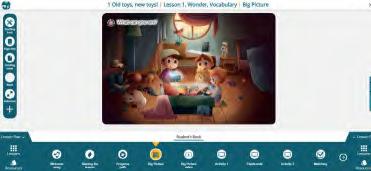
The presentation tool offers teachers online lessons for presenting the material using an interactive whiteboard or projector. The lessons contain activities mirroring the sequence of material in the Student Book and the Teacher’s Book but in an interactive format best suited to a digital experience with integrated answers, audio, video, and classroom tools. The lessons also contain all the audio for the course. Teachers can navigate the material using the interactive lesson flow or traditional page view. The planning area gives a useful overview with both teacher’s notes and activity previews. The presentation tool is also available offline.
Class audio




The class audio contains all the recordings for the Student Book and Workbook. All tracks are appropriately numbered on the pages of the Student Book and the Workbook. All audio for the series can be found in the teacher resources on the Pearson English Portal.



Assessment Pack










The Rise and Shine Assessment Pack contains everything needed for regular, formal assessment, including a Diagnostic test, Unit tests, Progress Review tests, and an End-of-Year test. The Assessment Pack is available on the Pearson English Portal.

Flashcards

There are 130 flashcards at Level 3, illustrating the two vocabulary sets for each unit. The lesson plans offer ideas and support for using flashcards to present, practice, and consolidate language through games and activities.
Story cards
Resources
The Pearson English Portal is an online location where teachers and students can find all the materials and tools that can be used inside and/or outside the classroom with Rise and Shine. Teachers can use it for lesson preparation, to deliver lessons, to assign and track homework, to monitor students’ performance, and to manage their classes. The resources available to teachers include: • assignable online homework with automatic grading, • a tool for tracking the performance of both individual students and the whole class, • an assessment pack, • all the audio and videos for the course in one place, • digital versions of posters, flashcards, and story cards, • extra resources, such as worksheets and games.
Posters

The story cards each contain one frame from the course story, with accompanying teaching notes, as well as the audio script for the story frame. The story cards are half letter size and easy to use.
The posters designed for Rise and Shine are a great visual aid and can be used throughout the course. The posters include an introduction to Rise and Shine Library and story characters, vocabulary items, the Student Book Progress Chart, encouraging mindfulness and a growth mindset.


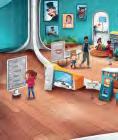
40 1 All about school! 10 Listen and point. Then listen Listen and say. What do you have on (Monday)? have (art) and (geography) on (Monday) routines. photo diary. Lesson 1 – Vocabulary Student Book page 10 Starting the lesson: warm up and song Play the Rise and Shine Welcome Song. Encourage students to use actions from the Welcome unit. Then practice with the karaoke version (audio track 0.03) and have students sing the words on page 4 of the Student Book. Big Picture: What can you see? Look at the Big Picture. Ask What can you see? Have students point at the picture. Ask them if they can see anything in the picture from the Ask students to think about their day today and to count on their fingers how many subjects they have. Encourage students to count aloud. Listen and find. school on the board. Draw on the board some simple visual clues to elicit subjects, e.g., draw a “plus” symbol for math. Ask students to look at the Big Picture. Play the audio and tell students to point to each school Ask a follow-up question, e.g., What’s Lena’s favorite subject? (technology). wonder page 11. Read aloud the question: Are school days the same in every country? Discuss the question. Most end at 3 p.m. Students typically have 25 minutes for lunch and a 20-minute recess. Ask students to point and say a subject they like in the Big Picture. 2 Listen and point. Then listen and say. Play the audio and have students point to the school subjects in the picture. Play the audio again and present the vocabulary flashcards for students to repeat each word. Play the audio again and have students repeat what they hear. Wonder Objectives to talk about school subjects Target language: math technology science history P.E. drama geography English music Recycled language: places library courtyard gallery reading corner numbers Productive: Speaking: 50–100. Receptive: Listening: Wonder: sparking curiosity Encourage students to think about any words they know connected to school before starting the lesson. You might want to review classroom objects, for example, before starting the lesson. Point to the “Wonder” stepping stone and write the learning objective on the board: We’re learning school subjects and numbers 50–100 Audio; video; Flashcards Starting the lesson t Learning path t Big picture t t Activity 1 t Activity 2 t t 1 41 Hold up each flashcard for students to say without prompting and ask them to point to the subject on the page. 3 Review school subjects vocabulary using flashcards. Tell students they are going to watch video about school days around the world. Before watching, ask students what they some vocabulary, e.g., schedule homework Discuss what children go to school by bus by car by bike Play the Our World video. learn in other countries. Are they the same or different? 4 Listen and say. Then play. Big Picture. Read them aloud and point to them. Then write the numbers 50–60 on the board. Point to each number and say it aloud for students to repeat after you. Play the audio and have students listen to the numbers they with the song. between 50–100. Their partner then says the number aloud. Have them do this a few times before swapping roles. Drill the numbers few more times and play the game as a class before students play with their partner, so they become more familiar with the numbers. In pairs, change the order of the game so
eighty-nine Read and number the pictures. rooms in the picture using the numbered words in the ANSWER KEY: Answers from left to right, top to bottom: 10, 4, 2, 6, 3, 8, 7, 5, 9 Look and write. Students write the subject to match the ANSWER KEY: music, history, 4 technology, English, Wonder helper: Students answer the question math, music, science likes or dislikes, then tell a partner about their preferences. Activity Audio script Yes, do, Thomas! Thomas What’s your favorite subject at school? Mine too! What other subjects do you like? Lena like history. have history on Mondays and Wednesdays. like geography, too. have geography on Tuesdays, Thursdays, and Fridays. But don’t like Fridays. Why not? Lena have music on Fridays. don’t like music. Why? Thomas Music is fun. Come on… Activity 4 Come on everybody, count with me! 50, 51, 52, 53, 54, 55, 56, 57, 58, 59, 60, 61, 62, 63, 64, 65, 82, 83, 84, 85, 86, 87, 88, 89, 90, 91, 92, 93, 94, 95, 96, 97, 98, 99, 100! activity t t Learning path t Activity 3 t Activity 4 t Helper t Ending t Course overview 11 wake up 99003.indd Rafa
Thomas
Does
STORY
Read Daniel’s sentence and question to the class. Put students into pairs and encourage them to point at the Big Picture as they say their favorite subject. More confident students can ask each other the question. Wonder Ending the lesson Write the following letters on the board: this is a school subject from the lesson, but the letters are in the wrong order. Put students into pairs to unscramble the letters and say the subject (music). Repeat the steps for other subjects. Workbook page 4 Then they write the missing words to complete each number. thirty-eight, sixty-seven,
Does the library have a villain?
No, the library doesn’t have a villain.
the library have a villain?
Pearson 99065.indd
Skills development in Rise and Shine
Support
Speaking Can use a few simple words to describe objects (e.g., color, number), if supported by pictures. (19)
Lowest within rangeHighest within rangeStretch
Can say how they feel, using a limited range of common adjectives (e.g., happy, cold). (22)
The skills syllabus has been developed using the Global Scale of English (GSE) Learning Objectives and the GSE Skill Development Framework for Young Learners, which provides structured scaffolding to support teachers and students.
At Level 3, the GSE range covered is 22–30 as core, but includes learning objectives as high as 35 as stretch.
The four skills are systematically developed within each level and across the course as a whole.
Reading: Tasks are designed to gradually increase proficiency in terms of speed, accuracy, comprehension, interactive reading skills, and use of reading strategies, as well as to enrich vocabulary. Texts used gradually increase in length and complexity over the course so that the challenge is always appropriate to the level of the students. At a high level, by the end of Level 3 students should have developed their early reading, decoding, and phonics skills introduced and practiced in Levels 1 and 2. They should comfortably recognize and locate basic and familiar words in simple sentences and short texts and use a range of basic everyday nouns and adjectives.
Writing: Writing skills are developed and coordinated with reading skills so that students are able to master both reading and writing in English. In Level 3, students build on their ability to write short and simple phrases with support and by the end of Level 3 should be able to write basic sentences on familiar topics.
Speaking: Speaking skills are taught through a meaningful task-based approach. The course draws on a range of approaches to teaching speaking, in which students have plenty of opportunities to engage in communicative activities. The course provides a supportive framework for students to make the language their own. By the end of Level 3, students should be able to recall skills introduced and practiced throughout Levels 1 and 2 and be able to answer simple questions on very familiar topics. Students should know and apply fixed formulas and expressions, and be able to respond politely and appropriately in a social context.
Listening: In Level 3, students are building on the listening skills that have been systematically developed across Levels 1 and 2 through predominantly aural input. By the end of Level 3, students should be able to follow short stories and animations if supported by gestures and repetition, understand the general meaning of new words and use the knowledge they have to be able to work out the role of a new word.
Can describe someone’s likes or dislikes in a simple way. (30)
Can talk about a familiar place in a basic way. (35)
Within the four language skills, the sets of learning objectives are grouped into strands relating to accuracy and appropriacy, complexity and organization, interaction, and strategies. Within these strands, the objectives are further grouped into specific areas of competency and then further aligned to key development indicators. See example:
Speaking
GSE Learning Objective: Can use a few simple words to describe objects (e.g., color, number), if supported by pictures. (19)
Competency: Building Complexity – talking about and describing a range of topics, situations, feelings, and attitudes with an increasing level of detail and complexity.
Development Indicator: Learners can use a few words to name, talk about, or describe familiar situations.

The development indicators capture each discrete skill that students are aiming to acquire. Breaking the skills down in this way supports the development of related skills that build on one another and are at the right level, giving students the best chance to learn and achieve.
The skill coverage charts on the Pearson English Portal show the key skills covered across the course and the learning objectives in each level that relate to these. By monitoring student performance on the tasks relating to these objectives, teachers can see how students are progressing within and across levels and where they may need more opportunity to practice, so they can build this into their planning. Note that lessons are based on individual learning objectives, but student progress is measured in terms of their performance on the key indicators selected for the course.
The Student’s Progress Chart enables students to think about and document their progress in an age-appropriate way as they move along the learning journey. Teachers can also use the chart as a clear visual reference to showcase students’ learning and progress to parents. A copy of the chart can be downloaded from the Pearson English Portal for students to complete.

12
Course methodology
Every unit in the Teacher’s Book starts with a unit overview of the key areas covered in the unit. As well as highlighting target language for the unit, it also acts as an at-a-glance guide to the unit objectives and key progress indicators.
Future skills are general and transferable skills that contribute to how someone functions in the world, both individually and with others, and are sometimes known as “soft skills.” These are personal and social skills that students will need to become responsible citizens and include well-known skills such as collaboration, communication, critical thinking, creativity, social responsibility, self-management, and leadership. Future skills are embedded in the course activities and modeled by the course characters throughout. Clearly signposted sections in the teaching notes provide extra support to teachers through tips and ideas to further enhance future skills learning and practice. The Future skills lessons in the Student Book enable students to learn about and develop specific skills further, with detailed teachers’ notes available on the Pearson English Portal to support the delivery of these lessons. Individual skills are developed systematically in the following ways.
Enquiry and imagination
The Global Scale of English (GSE) is a standardized, granular scale that measures English language proficiency. Unlike some other frameworks that describe attainment in broad bands, the GSE identifies what a learner can do at each point on a 10–90 scale across speaking, listening, reading, and writing skills. The scale is designed to motivate learners by giving more granular insight into learning progress. Teachers can use the GSE level to match a student to the right course materials for their exact level and learning goals.
The badging on the back of the Student Book indicates the GSE proficiency range from which the learning objectives for that course level have been selected. A course will not cover all learning objectives from that range – just a representative selection that is appropriate to the target learners. Knowing this range helps you select additional materials with the right level of support and challenge for your students to help them progress. It does not mean that students need to have mastered all objectives below the range before starting the course, or that they will all be at the top of the range by the end.







The Global Scale of English framework contains learning objectives for all four skills for language learners in four different domains: Young Learners, Adult Learners, Academic Learners, and Professional Learners. The objectives in each set have been rated by experts and teachers in each of those domains from around the world for their relevance and level of difficulty for learners in that context.
To see full sets of the objectives and for more information about using the GSE to support teaching and assessment of your learners, please go to www.english.com/gse.
In all levels of Rise and Shine, students are provided with opportunities to be creative and use their imaginations, through stories, activities, and projects. In lower levels, creative-thinking skills are facilitated through activities that promote new and original ideas and help students express themselves. Students may be asked to evaluate ideas and communicate new ideas to others. At higher levels, students are encouraged to use mind maps.
Critical and reflective thinking



Activities in Rise and Shine have been developed to provide a level of cognitive challenge in line with students’ age. As they move through the course, students are asked to engage with the language using lower-order and higherorder thinking skills, as appropriate. There are constant opportunities for information processing, using skills such as following instructions, locating and collecting information, classifying, and sequencing ideas, which contribute to students’ ability to retain and confidently use the key language. Rise and Shine also provides students with consistent opportunities for self-assessment and reflection.
Collaboration and communication

Rise and Shine offers a unit structure that encourages students to work together towards a shared goal. Individual and pairwork activities develop throughout the course from short answers and dialogs to groupwork and team projects. As communication and collaboration are integrated with other skills, a holistic approach is encouraged and promoted from the outset to encourage shared participation and responsibility to find answers with valued individual contributions.
Social responsibility and global citizenship







Social responsibility is all about encouraging students to take responsibility for their behavior in the world and to behave with sensitivity towards social, cultural, civic, and environmental issues. Rise and Shine encourages this through a strong global citizenship syllabus that invites students to take an active role in their

13
38 All about school! 1 in Unit 1, the students will: Key learning outcomes Understand overall meaning and main idea(s) from short sentences and texts on everyday topics Participate in social exchanges in English Write simple sentences on familiar topics Create a school day photo diary Name or describe people or common objects or express basic opinions in a few words Wonder Imagine Build Grow Shine M01_RS_TB3_99188_M01.indd 38 1 39 Target vocabulary School subjects: art, English, geography, history, technology, math, music, P.E., science brush my teeth go to bed, go to school, have breakfast, take shower, wake up classroom, homework, playground, schedule Recycling and building days of the week, telling the time Language stretch Wow! Functional language How do you go to school? go (to school) by (bus, car, bike), walk (to school). Pronunciation /ɔɪ/ (boy), /ɒːk/ (walk) Values learn about different school days. Competency focus Understand the importance of being motivated and curious to learn, and develop good learning habits. Unit overview Key progress indicator chart Target structures What do you have on (Monday)? have (art) and (geography) on (Monday). What time do you (wake up)? (wake up) at (seven o’clock). GSE range for Level 3: 22–30 (stretch 35) Development indicator: Speaking Have a short conversation about my world. Working towards: taking part in a simple conversation of 3–4 exchanges on a familiar topic, and at the highest level being able to give a simple, prepared talk. Can recognize familiar words and basic phrases in short illustrated stories, if read aloud slowly and clearly. (24) Identify and understand simple information and details in short spoken texts or conversations. Can answer simple questions about their daily routines using gestures and short, fixed expressions. (29) Participate in common informational, academic, or transactional exchanges using simple language and expressions. Can say how they and others get to school every day in a simple way. (30) Use simple language to talk about and describe familiar objects and situations or express basic opinions or attitudes in short stretches of speech. Writing Write simple sentences about the world around me. Working towards: writing a short text of 4–6 sentences on common topics, and at the highest level being able to write for a range of social and interpersonal purposes. Can write a single, basic sentence about daily routines and activities. (28) Write simple sentences on familiar topics and situations. M01_RS_TB3_99188_M01.indd 39 Future skills Course methodology Global C tizen friends Global Citizen friends Global Citizen toys! toys! Global Citizen toys! toys! Global Citizen families! Global Citizen families! Global Citizen I play with friends! play with Global Citizen play with friends! play with Global Citizen try different food! try different Global Citizen I try different food! try different Global I appreciate special appreciate special Global appreciate special appreciate special OptA OptB OptC OptD Lorem ipsum Global Citizen
community and collaborate to make the world more equal, fair, and sustainable. It fosters the belief that every student can make a difference.
Rise and Shine puts particular emphasis on cultural awareness, empathy with local and global issues, and social-emotional skills development. Context and content in the Imagine and Shine stages support the development of responsible global citizens, while the Grow stage provides the opportunity for students to consider the wider world. Activities use the global context to encourage students to think about both local and global relevance.
Future skills helpers
The Rise and Shine unit stages link to future skills and each stage has a dedicated “helper” who guides and supports students in activities that develop these skills.
The Wonder helper Daniel sparks students’ interest and enquiry with a personalized question.






• Enquiry

• Critical and reflective thinking
The Imagine helper Alicia engages students with the story and encourages them to think imaginatively, creatively, or critically.
• Imagination

• Critical and reflective thinking
The Build helper Lena builds confidence and self-management, and encourages communication and collaboration by leading a motivating chant.
• Communication
• Self-management
The Grow helper Thomas asks questions that encourage children to draw comparisons between the lesson content and their own lives and to think as global citizens.



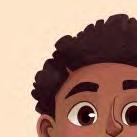
• Critical and reflective thinking

• Social responsibility
Self-management


Self-management enables students to organize their work and progress through skills such as organization, planning, persistence, and attention to detail. Activities in Rise and Shine are carefully staged, and more complex activities, such as writing and projects, are presented in clear steps to support students as they learn to plan and organize their time. Students are also actively encouraged to assess their own learning and progress by participating in the I can shine activities at the end of each stage of the unit.
Rise and Shine promotes persistence and a growth mindset in the classroom, which helps students view ability as something that is changeable rather than fixed. Activities encourage students to relish challenges, embrace their mistakes as part of the learning process, value the importance of effort, respond carefully to feedback, and take inspiration from others. This will help them achieve, not only in the English classroom, but also in their future lives as adults.
The Teacher’s Book offers teachers extra support by explaining how images, stories, and activities spark curiosity, foster imagination and creative thinking, build confidence, nurture growth, and allow students to shine.
Rise and Shine and the UN Sustainable Development Goals




In 2015, all UN Member States adopted 17 Goals as part of the 2030 Agenda for Sustainable Development – a global call to action to protect the planet, end poverty, and improve the lives of all the people.
In Rise and Shine, the overarching unit topics have been developed with reference to the UN Sustainable Development Goals. The content and context for the stories support in developing responsible global citizens. The Grow lessons, in particular, provide the opportunity to expose students to the wider world and use the global context as a springboard for thinking about both local relevance and bigger-picture ideas. The end-of-unit project is a vehicle through which students can explore wider global citizenship themes and some of the UN Sustainable Development Goals, such as:
SDG 3: Good health and wellbeing (being motivated, learning new hobbies and skills; Unit 4)

SDG 4: Quality education (understanding the importance of learning; Unit 1, Unit 3)


SDG 11: Sustainable cities and communities (participating in community activities, important places; Unit 2)

SDG 15: Life on land (respect for animals, exploring nature; Unit 5)
For more information on the UN Goals, please visit https://www.un.org/sustainabledevelopment/


14
Course methodology
Unit title: sets out the quest for the unit and the project end goal.






























Progress path: sets out the learner journey and reaffirms the stage the students are on.

I wonder question: engages students with the unit topic and sparks curiosity. Students find out the answer to the question in the unit.
Lesson 1
Wonder stage: activities to spark curiosity.

• Presentation and practice of vocabulary with audio support. Previous knowledge of the topic is activated through an Assessment for Learning activity.




• Students listen to the key unit vocabulary in the context of a dialog between the characters.

• Target vocabulary is included in the engaging and highly illustrated big picture.
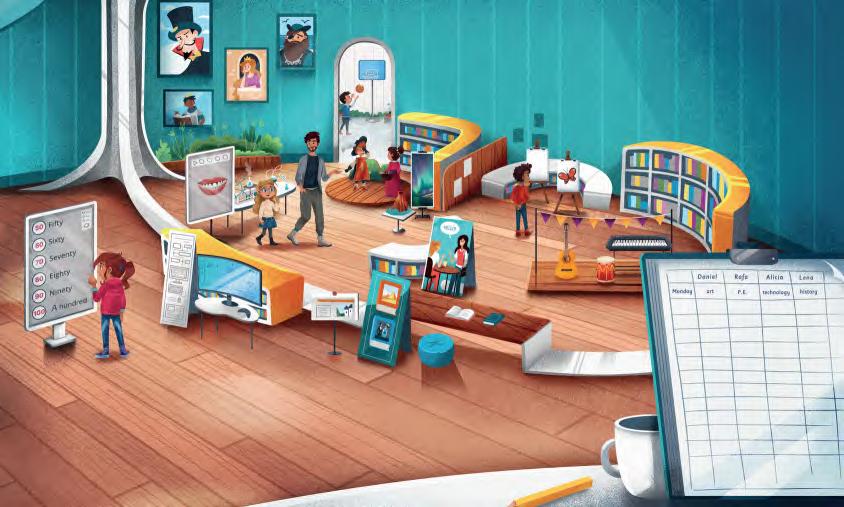
• Our World video, with real-life footage, promotes learning in context.
• The Pearson English Portal offers students of all levels further practice to help reinforce the learning objectives and consolidate their learning.



• The Workbook Word connections list helps students to review vocabulary.

Digital: Flashcard presentation, Our World video, extra vocabulary practice.


Lesson 2
• Presentation and practice of grammar with audio support through a song. New structures are presented through a song and consolidated.

• Clear and concise learning objectives help clarify the aim of the lesson for the teacher and parent.
I can shine at the end of the lesson practices the language and structures in a communicative speaking task.
Further practice of the target language is provided in the Workbook for all lessons. Lesson 9 provides students with an opportunity to consolidate and personalize their learning through the lapbook activity.

Digital: Grammar presentation and additional grammar practice, karaoke song.




15 Course methodology Unit walkthrough Library
about school! 10 11 I can shine! 2 7 10 1 6 4 3 8 9 5 Lesson 1 What can you see? 1 1.01 Listen and find. 2 1.02 Listen and point. Then listen and say. Lesson 2 1 1.04 Read and sing. 2 1.06 Listen and circle true (T) or false (F). 1 T / F 2 T / F 3 T / F 4 T / F 3 What do you have on Monday? Say. 3 Watch and listen. 4 1.03 Listen and say. Then play. 4 Ask and answer. Vocabulary School subjects Song and structures What do you have on (Monday)? I have (art) and (geography) on (Monday) Say what I have at school each day. Read about subjects and daily routines. Say how I go to school. Write a diary entry. Create a photo diary. I can say what I have at school each day. Wonder Every day I go to school, School is fun! School is cool! What do you have on Monday? On Monday at school? I have math and geography! What about you? Chorus What do you have on Tuesday? On Tuesday at school? I have art and music! What about you? Chorus What do you have on Wednesday? On Wednesday at school? I have science and P.E. What about you? Chorus Song Imagine Build Grow Shine 1 math 6 drama 2 technology 7 geography 3 science 8 English 4 history 9 art 5 P.E. 10 music I wonder… Are school days the same in every country? What do you have on Monday? I have art and geography on Monday. I like art. What subject do you like? What do you have on Tuesday? I have…
All
11 Lesson 8 Unit 1 Review 1 Find and circle. Then write. 1 2 3 3 2 4 art 5 7 6 8 TECHNOLOGY GWOIZTPHYM UARTXTZBVU EKBDFPGROS NEWQMENMLI GUDTLGSDRC LPJHWSPSZV IYGOTOBEDA SYFSDHUIPR HXHISTORYT 2 1.20 Write. Then listen and check (✓) 3 Write and answer for you. Then talk with a friend. Extra time? What are these school subjects? a a d m r e g o g a y p h h t a m Home–school link Tell your family about your perfect day. Lesson 9 Time to shine! 1 Think and write. 2 Make your lapbook. Find pictures or draw. Then write. My Perfect Day 1 What time do you wake up? 2 How do you go to school? 3 What subjects do you have? 4 What do you do in the evening? 5 What time do you go to bed? Morning Afternoon Evening take a shower brush my teeth have breakfast do my homework play on the playground read comic books play tennis P.E. English art math drama 10 My perfect day What do you have at school on Monday? What time do you ? What time I have and take a shower at I have breakfast How do you go to school? I
Lesson 3
Imagine stage: stories and activities to encourage cognitive engagement.
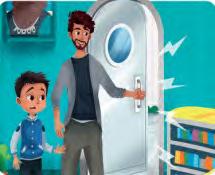









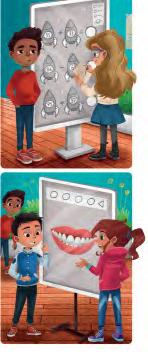
• Six new vocabulary items are presented as a cohesive set.
• A pre-reading activity that uses simple reading strategies and a Vocabulary 2 review.

• The story develops reading skills and strategies.
• A reading comprehension activity that checks understanding of the text, provides additional vocabulary practice, and further develops reading skills appropriate for the level.
• The I can shine reading comprehension provides further consolidation of the text and gives students the opportunity to personalize the story.
• The Workbook Word connections list helps students to review vocabulary.

Rafa Does the library have a villain? Thomas No, the library doesn’t have a villain.

Lesson 4
Build stage: meaningful language input and activities with a strong focus on building communication skills and confidence.
• Presentation of Grammar 2, contextualized through listening with the course characters as an extension of the Lesson 3 story, with further vocabulary practice.









• A motivating chant led by Lena the Build helper.
• Controlled, personalized practice of the grammar within a meaningful context.
Digital: additional grammar practice and chant.



Role-play feature – students are encouraged to collaborate to role-play the story.



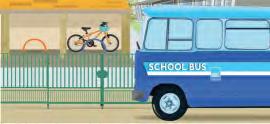
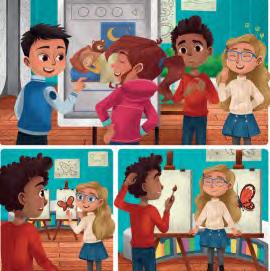
Digital: Story animation, additional pre-reading support, flashcard presentation, extra vocabulary practice.








• Story cards can be used in a variety of ways to support students’ learning – see page 11 for more information.
Lesson 5
• A clear presentation of key functional language in a relevant context.
• A pairwork activity that provides the opportunity for students to repeat the speaking model.
• A light pronunciation strand that pulls out sounds from the language in the unit.

















































• Communication cards that are tied to GSE speaking skills Learning Objectives.
Digital: Communication cards, extended pronunciation presentation and practice.













16
Does
1 1.08 Listen, point, and say. Lesson 3 wake up have breakfast go to school brush my teeth take a shower go to bed 2 Look at the story. What subjects can you see? Write. I can see 3 1.09 Listen or watch. What do you learn about teeth? 1 3 5 2 4 6 Math can be fun! Look at the teeth! Not me! I only have 19 teeth, look! Do you know that adults have 32 teeth and children have 20 teeth? I don’t like math. I have math on Monday, Wednesday, and Friday at school. 12 13 I can shine! I can read, understand, and role-play a story about subjects and routines. Imagine you are Daniel at the school subject fair. Role-play the story. Wonder Imagine Vocabulary Routine actions Understanding the importance of all subjects. 4 Read again. Then match. 1 Alicia 2 Daniel 3 Rafa 4 Lena a I only have 19 teeth. b I go to bed at eight o’clock. What time do you go to bed, Alicia? Look, Daniel, this is symmetry. Symmetry is math and art. Yes, I think I like math now. Ha ha, that’s math, Daniel! I go to bed at eight o’clock and I wake up at seven o’clock in the morning. Wow, you sleep for 11 hours every night! That’s 77 hours a week! Wow, it’s amazing. I want to paint, too. Library When do you use math? Build Grow Shine Lena and Daniel are at the math stand. Alicia and Rafa are at the science stand. Oh, wow, look at the math game. Course
the library have a villain?
methodology
1 1.10 Listen and check (✓). Which timeline shows Lena’s day? Listen and read. Then chant. Ask and answer for you. I wake up at seven-thirty. What time do you wake up ? Lesson 4 3 Listen again and say. 1 Look and write. What transportation can you see? I can see Lesson 5 2 1.12 Listen and read. Then answer for Anna. 14 15 I can shine! I can say how I go to school. 5 Ask and answer. Find out how your friends go to school. I go to school by bus. How do you go to school, Anna? Pronunciation Imagine Build Structures What time do you (wake up)? wake up at (seven o’clock) Communication Asking and answering about going to school. by buswalkby bikeby car 4 Listen to the sounds and say. oys walk to school. They take their toys and they talk Grammar builder What time do you wake up? brush your teeth? I wake up at six-thirty. I brush my teeth at seven o’clock. A 12 12 12 6 12 Ask and answer about my day. Wonder Grow Shine How do you go to school? I go to school by bike. I go to school by car. How do you go to school? 6
oy t
M01 Shine AmE 99065.indd 24/6/21
Grow stage: activities to see real-world content that opens students’ eyes through a global citizenship strand.




• Real-world reading text.























• Four new vocabulary items are presented within the text that tie in closely with the unit topic.




• Comprehension with critical thinking.



• A listening task that extends the topic explored in the lesson and develops listening skills appropriate for the level.






• Thomas the Grow helper asks a question that encourages children to draw comparisons between the lesson content and their own lives.
Lesson 7












• The model writing text relates the global citizenship strand to a real-world and functional context known to students.
• An Ideas generator activity that helps students personalize the context and provide further ideas for their own writing.




































Lesson 8




Shine stage: activities stepped out to allow all students to showcase their achievements and feel a sense of pride.
• Students “reimagine” what they have learned in their own context in answer to the unit title.


































students






















































Step 1: Review and personalization through differentiated “steps” allows all students to showcase achievements and feel a real sense of pride.













• Recycles and reviews language input from the unit and provides controlled speaking practice.




















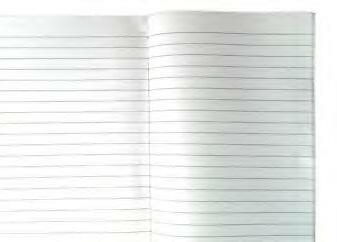

Lesson 9
Step 2: Students think and create.
Give it a go



activity that provides step-by-step planning, reflective of the model text, to support students in structuring their writing.
Students produce their own version of the text genre/realia I can shine activity, simultaneously practicing the vocabulary and grammar structures learned in the unit.
Time to shine: Students share their project with the class, encouraging communication and collaboration.
17
Lesson 6
Glob Ci ien friends Glob l C ien Glob C en Glob C ien friends! Glob Ci ien food! Glob C ien special clothes OptA OptB Lorem ipsum Global Citizen I appreciate different school days. Read again. Then circle true (T) or false (F) for Chen. My schedule tells me what subjects I have. T / F There are 40 students in my class. We have classes on the playground. T / F 1 1.18 Listen and read. What’s Carla’s favorite day? Lesson 7 itago Plan your diary entry with a friend. Lesson 6 shine! I can write a diary entry. Build Grow 1 Look. Is your school day different? 2 1.15 Listen and read. What subjects does Chen have on Monday morning? My favorite day is Thursday. have breakfast at school. I have science, math, art, and English. I help in my school library on Thursday afternoon. It’s fun! Choose your favorite day at school. What subjects do you have? What other things do you do? Hi! I’m Chen and I’m from China. This is a schedule for my school day. This is my classroom Classes start at seventhirty. There are 40 students in my class! On Monday, we have math, English, history, and geography in the morning. wake up at six-thirty. go to school by bus at seven o’clock. Imagine Wonder Shine TIMEMONDAY
Step 2 Create Choose and write your favorite school day. Tell your group about your favorite day. Take pictures or draw the things you do on that day together. 8 Create a photo diary. 19 Grow Grow Shine Unit project A photo diary Time to shine! Present your photo diary to the class. 10 What’s your favorite school day? I wake up at six-thirty. I have breakfast at We have geography, P.E., and history on Thursday.
7:30 math 8:30 English 9:30 history 10:30recess 11:30geography 12:30lunch 2:30art 3:30 technology 4:30music
Build Imagine Wonder I like Wednesday. We have English, math, science, and art. What do we have on Wednesday? 14/7/21 12:28 PM Course methodology seven o’clock. 1
My school day photo diary
we play on the playground have two hours! I do homework I go to bed at nine-thirty. I’m tired!
Give it a go Friday. go to school is Tuesday. I have I
Measuring progress in Rise and Shine
In Rise and Shine, students engage in a variety of contextualized activities, each of which focuses on a particular Global Scale of English (GSE) learning objective. These objectives are fully supported by the Rise and Shine Assessment Pack. However, fair and accurate assessment in a language classroom reflects not only what students can recognize and produce in a test, but also what they can perform or do as they actually use the language in real or realistic contexts. To evaluate students’ progress fairly and fully, both of these aspects must be part of an effective approach to assessment.
Assessment Pack
The Rise and Shine Assessment Pack is a useful evaluation tool with a wealth of activity types to support teachers in assessing the students’ language skills. In this pack, teachers can find four kinds of ready-made tests that will help them form an accurate evaluation of their students’ understanding and achievement. The Assessment Pack is available on the Pearson English Portal.
Diagnostic tests are designed to help evaluate students’ current language ability in English against the learning outcomes of the course. This should be given at the start of the new level and will help provide a picture of students’ existing knowledge. It also provides awareness for teachers of where individual students or the class may need more support as they work through the course. This should be administered in a relaxed and supportive atmosphere.
Unit tests correspond to the content material in each of the units and reflect the learning objectives of the unit. These tests provide a useful snapshot of student achievement at the end of a unit and also provide feedback to teachers and students on the progress made against the unit learning objectives. These tests can help identify any areas where further support is needed for individuals or the whole class. The test results can also help teachers adjust plans for the next unit and any further practice.
Progress Review tests serve as checkpoints throughout the year to provide teachers with a way of checking progress towards key learning outcomes for the level based on students’ performance on activities aligned to the key competency indicators. As with the Unit tests, information gained from these should be used to identify areas where students may need additional practice or support. Progress Review tests additionally reassess student understanding and retention of the language and concepts taught in the previous units. This repeated practice helps students remember and integrate material learned over time and supports teachers in making decisions regarding which language points and skills need further review.
The End-of-Level test provides teachers with a tool to assess progress against all of the key competency indicators for the level and to assess class readiness for the next level. It helps teachers evaluate the level of students individually and as a whole class, and supports decision-making and planning for the next level.


Diagnostic, Progress Review, and End-of-Level tests focus on objectives relating to the key learning outcomes for the level in order to provide teachers with a clear, measurable way to track students’ progress towards these over the course of the year. The Progress Review and End-of-Level tests are cumulative in order to provide a clear picture of the progress students are making. The Unit tests are focused on the learning objectives of the specific unit and are not cumulative.
Each test has A and B versions available. These versions assess the same learning objectives and language at the same level and are provided for simultaneous use to provide variety in large classes. Each test also has a C version to enable students who require extra support to achieve a similar minimum standard as the rest of the class. Unit and Progress Review tests also have a D extension to provide additional challenge to students who may have mastered the content more quickly than the rest of the class.
The Assessment Pack also includes access to a test generator, which teachers can use to create and tailor tests for specific needs and situations.
English Benchmark Young Learners is a motivating English test for young learners aged 6–14, which can be used to understand students’ English abilities, identify their learning needs to ensure teaching targets the right skills, and monitor and demonstrate progress to parents. English Benchmark measures students’ speaking, listening, reading, and writing skills through fun and interactive tablet-based activities, with immediate detailed reports for teachers and parents that include students’ strengths, suggestions for improvement, and recommended activities to improve their skills. As students learn with Rise and Shine, English Benchmark tests can be used to measure their progress. After students have taken their test, recommendations are available on areas to focus on to support improvement.
In Rise and Shine, the Level 1 End-of-Level test includes key skills and activity types covered in English Benchmark in order to prepare students to take the test the following year, at the end of Level 2. From Level 2 onwards, it is advised that students take English Benchmark Young Learners test once per academic year, at the end of each completed level of the course. For more information, visit pearsonenglish.com/ benchmark.
18
Course methodology
English Benchmark Young Learners
Assessment for Learning
Rise and Shine includes Assessment for Learning methodology, which supports students along their learning pathway. This methodology is embedded within every lesson across every unit in each level of the course. Assessment for Learning methodology provides a clear and easy-to-use framework that enables students to take responsibility for their learning and teachers to support the learning progression of each student in their class.
What is Assessment for Learning?
Assessment for Learning is more than testing. It involves an ongoing engagement with students, so that what they know now helps inform what they learn next. A balanced approach to assessment includes frequent informal prompts, games, and other activities that allow students to understand where they are and identify gaps in their understanding. When informal assessments are integrated into the classroom, students take an active role in their own education and seek out the help they need to meet their goals.
One aspect of assessment that is frequently overlooked by traditional approaches is positive reinforcement. All students need to be encouraged by acknowledging skills they have successfully acquired. Focusing attention only on mistakes or unlearned material creates disengaged, dispirited students. Always be sure to praise students for skills they have successfully acquired before identifying those which need work. Beginner students are especially responsive to positive feedback.
Assessment for Learning in Rise and Shine
Assessment for Learning in Rise and Shine incorporates a number of techniques that help build a supportive and motivating learning environment.
Introduce
At the beginning of each unit, there are activities designed to introduce the key topic of the unit and spark students’ interest. These activities help you set clear learning goals and connect them to the Time to shine task at the end of the unit, giving students a direction and sense of purpose throughout the unit.
Diagnose Diagnose
The first activity in each lesson is designed to activate prior knowledge and help you diagnose levels before introducing new language. These activities are designed to review language previously introduced in the course and to provide opportunities for students to share anything they already know about the topic.
Support and recycle
Activities throughout the unit support the learning of the key language, from presentation to recognition, controlled production, and freer production. Language is systematically developed and built up over the course of the unit leading to the final Time to shine project task, giving students of all abilities the opportunity to shine.
Reflect

Each stage in the unit has a dedicated character “helper” to guide students and give them a confidence boost. The character also enables students to extend their knowledge further.
GROW HELPER
Introduce Thomas the Grow helper to the class. Have students say which activity they want to do.
Assess
Assess
Each stage of the unit has a clear, measurable outcome that students can demonstrate in the I can shine task. These activities are specifically designed to consolidate learning from the stage and to demonstrate to students what they have learned and how what they are learning contributes to the unit project. This activity is also an opportunity for teachers to monitor progress and assess how students are doing against the learning objectives. Using the Achieve, Adjust, Exceed guidelines provided in the Teacher’s Book, teachers can support every student to shine.
I can shine!
Assess
ACHIEVE The student can ask and answer fully about what subjects they have on which day.





ADJUST The student can answer the question in a simple way, with support, e.g., art and geography.
EXCEED The student can add additional information about the subject in their answers, e.g., It’s my favorite subject.


19
Introduce Course methodology
Working with projects in Rise and Shine
At the end of each unit, the Time to shine projects offer students the opportunity to apply the skills they have learned in the unit through a fun, achievable project. Projects have been especially designed in multiple steps, starting with a language review, so that all students can achieve. Teachers may choose to assign only some of the steps to students who need extra support and bring the whole class together at the end, so that every student feels a sense of achievement. Having the chance to shine at the end of a unit in the form of the project gives students a clear purpose and a strong connection to their world knowledge and interests. The context of the final project links back to the unit title and allows further exploration of the global citizenship strand and themes from the stories. This allows students to “reimagine” what they have learned in their own context in answer to the unit topic.
Communication and collaboration are key to successful projects in Rise and Shine. Students are encouraged to verbalize opinions and interact with their classmates, enabling a real communicative context to develop in the classroom. Students also develop their collaboration skills by working towards a group goal for projects. This allows learning to take place in a group and the final product is co-constructed. Roles and responsibilities in the group are agreed and can be flexible, giving students opportunities to take on different roles and develop different skills.
The project itself is clearly scaffolded into mini-steps, giving students a sense of achievement and the ability to apply English to express their ideas. It is important that students make their own decisions about each project, including how they work and what they create. Each student has their time to shine through their unique work on projects. The final step enables all students to collaborate regardless of ability, e.g., a class vote.
Tips for carrying out project work in class
• Prepare students by having them think about the project in advance. Allow students to come up with their own ideas and feed back on their ideas where appropriate. Allow students to showcase their idea and project in their own words and their final output for the project.
• Assess the quality of projects by using other work as a reference. Help students understand expectations by showing them good examples of other students’ work. Develop scaffolding to help students reach the standards and include both individual and group grades.
• Promote full participation by encouraging students to offer feedback on their classmates’ projects. Students should offer positive comments, e.g., I like the drawing, and could offer suggestions for improvement where appropriate, e.g., You could use more colors.
• Provide opportunities for student reflection both for the process and for the final product. Ask students to think about what they might do differently or change about their project now that they have finished and heard feedback from their classmates.
Many international curriculums encourage Project-based learning in the elementary school classroom because it nurtures relationships and a culture of creativity and innovation.
Rise and Shine draws on Project-based learning, which is an engaging multidisciplinary approach to teaching and learning that encourages students to solve real-world problems. Project-based learning is collaborative and hands-on, asking students to work with peers, teachers, and experts in their communities and around the world to ask good questions, develop deep subject area knowledge, identify and solve challenges, take action, and share their experience.
Project-based learning:
• provides a flexible framework for learning with multiple entry points,
• gives students ownership of their learning,
• focuses on challenges with clear solutions,
• promotes the authentic use of technology,
• develops future skills,
• encourages deep reflection on teaching and learning.
20
Course methodology
Managing inclusive classrooms
Rise and Shine is designed to support inclusive classrooms and helps teachers create an environment where all students can access the same learning.
• Activities in the Student Book support Assessment for Learning and allow students to personalize their responses.
• Three-tiered guidance (Achieve, Adjust, Exceed) in the lesson notes supports teachers in measuring progress and managing expectations for the I can shine activities to allow all students to perform to their ability.
• A stepped Time to shine project with help for teachers to adjust their expectations makes it possible for all students to participate in some way and feel a sense of achievement. The course offers scaffolding to learning outcomes and support for achieving, adjusting, and exceeding based on expectations.
• Embedded tips within lessons suggest differentiated teaching methods, including drawing on the skills and abilities of different students.
• Additional exposure, scaffolding, and practice on the digital offering provide extra support for those who are struggling or need to be challenged.
Throughout the Teacher’s Book there are targeted teachertraining tips to give teachers their time to shine.
TEACHER TIME TO SHINE: personalization
Students engage with topics more if they relate them to their own life. Before the lesson, find a blank Monday–Friday schedule. Encourage students to complete the schedule with their typical week at school.
Additional support for mixed abilities and the inclusive classroom can also be found on the digital presentation tool.
Strategies to benefit all students in inclusive classrooms
Set clear objectives Rise and Shine sets out student-friendly objectives in the Teacher’s Book for each lesson. Sharing this with students at the beginning of the lesson and making sure they know what to expect (and what is expected of them) decreases anxiety and allows students to prepare themselves for the tasks they find more difficult and look forward to the tasks they enjoy more.
Diagnose before presenting new language By taking the time to ascertain what students already know on a topic, teachers gain instant feedback on what to focus on in the lesson. This is particularly useful in inclusive classrooms where there may be a very wide range of knowledge among students. Rise and Shine offers a diagnostic activity in the Teacher’s Book before presenting any new language.
Take a multisensory approach Useful with all elementary school students, students with additional needs draw extra benefit from encountering language in multiple modes. Multisensory approaches are recommended for students
with dyslexic tendencies. Rise and Shine presents language through text, images, audio, song, and video. Ensuring a balance between different modes holds the class’ attention and sets up all students to achieve.
Give more space to activities Allowing students the time and flexibility to do activities in a way that suits their needs will ensure that all students can participate in the same activity, increasing confidence and motivation. Students who struggle with written tasks, for example, may benefit from doing only one or two task items in written form and completing the rest of the activity orally.
Adjust expectations rather than materials Expecting all students to achieve at the same level is often unrealistic and puts undue pressure on students with additional needs and teachers alike. Written activities in Rise and Shine are structured to increase in difficulty, so that all students can complete at least some of the activity. Some may complete only the first few task items, but being set the same activity as the rest of the class avoids students feeling singled out and increases confidence.
Give all students opportunities to speak While some students will be confident speaking up in class, others may feel anxious, especially if they have speech difficulties or are particularly shy. Organizing some speaking activities as pair or small group tasks allows all students to practice speaking in a safe environment. Check in with students regularly on how they feel about speaking in class, as even the most anxious students may be waiting for their moment!
Continuous repetition Rise and Shine is structured to repeat and recycle key language continuously and consistently throughout the course. However, regularly reviewing key language in class benefits all students. Display important vocabulary or structures on the wall or on the board as a reference for students.
Involve students in the creation of extra materials
The whole class can be involved in the preparation of display materials for the classroom, such as posters or charts, or individual materials, such as a personal dictionary for key vocabulary. These tasks give students control and choice and give the opportunity for those with linguistic difficulties to combine skills they feel more confident in with English. Meanwhile, students needing extra challenge can be encouraged to research and extend language.
21
Practical tips and planning
Teaching with video
Video is a great tool for conveying information to young students. A combination of images, movement, colors, sounds, music, and language supports learning at all levels. Students may watch the same videos many times and each time their perception of the material they watch is enhanced. Video plays a crucial role in Rise and Shine and is an engaging and interactive resource for students. Rise and Shine offers two kinds of video: real world and story animations.

Our World video
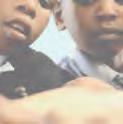
Rise and Shine includes six videos using real-life footage. These videos follow the unit topics and add a real-life documentary feel to the content of the unit. These videos are designed as a flexible resource, to be used at multiple points in the unit. Each one can be used at the start of a unit of work along with the Big Picture to introduce the topic. It provides exposure to Vocabulary 1 and Grammar 1 receptively in context. The topic also links to the real-world global or local angle in the Grow stage and if time allows, it can be used in Lesson 6 to support the global citizenship theme. The video can also be used in the Lesson 8 Unit Review to give students a chance to reflect on how much more they understand of the video now that they are close to finishing the unit. Worksheets for Our World videos are available on the Pearson English Portal.
Practical tips for using video
Watching the video allows students to see language learned in another context. It is likely that during the first viewing students will not understand the entire text presented in the recording, but they will get the meaning of the pictures, sounds, and the rhythm of the spoken language. They will remember some phrases, especially those that are repeated often.
• Use the animations and the videos to review the material. Children have a good short-term memory, and watching the same episodes again two months after they were first shown will considerably improve their ability to memorize.

• Watch the video with students from the beginning to the end. Encourage students to say the English words they remember from the recording.
• Watch the video again, stopping the recording after each scene, so that you can ask students questions about the things they see.

• Listen to the video with the screen covered (blind listening) and ask students about what they heard to support listening skills development.
• Watch the video with the sound muted (silent viewing) and ask students to name objects, describe the scenes, or imagine what is being said to review key language and support critical-thinking skills.
Story animations
Rise and Shine offers eight story animation videos to accompany the story in the Student Book. These animations bring the story to life and encourage students to revisit the story again and again. Animations can be used alongside or instead of the class audio of the story. The characters in the animation encourage students to interact with the story by asking a question for them to answer.


22
Practical tips and planning
Facilitating speaking











While speaking activities appear throughout the units in Rise and Shine, the Build stage provides a special, supported opportunity for students to build up a short exchange in a safe environment. Communication cards are provided to support confidence building. The cards link thematically with the unit topic and vocabulary, and allow for personalization of the functional language in lesson 5. This helps make the language meaningful for students. The focus on communication comes through clearly in this lesson through speaking strategies that allow for scaffolded steps. This is the main opportunity before the final Time to shine task to build confidence in oral production and consolidate language learned so far.

Tips for encouraging students to speak in the classroom

• Give your students a reason to speak. A conversation starter is a good way of doing this. Make sure that students are provided with the language and the scaffolding they need.
• Ensure students know what they need to do. Always demonstrate the activity with a volunteer.


• Provide plenty of opportunities for pair or small groupwork. While some students always volunteer to speak in front of the class, others are nervous and may speak more in the relaxed setting of a small group.





• When students work in pairs, be sure to monitor and praise them, offering support where needed.

• Allow enough time for students to complete the task, especially when working in small groups. Shy students especially feel demotivated if they miss their opportunity to speak because of time constraints.
• Provide extension activities for fast finishers, so that they do not disrupt other students and all students get the opportunity to finish the task.









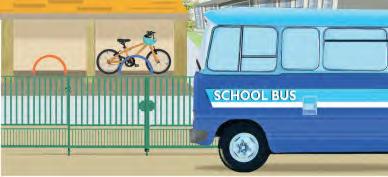









To develop learner confidence, Rise and Shine offers visual activities throughout the level that can act as conversation starters to support speaking. These can be extended into a think-pair-share collaborative learning task. These also provide the opportunity to pair stronger and weaker students for differentiated support.


• Pair students strategically. Experiment with pairing stronger students with ones who need more support for some activities, while pairing students at a similar level for others.

• Speak as much English as possible in the classroom. Deliver instructions in English, even if they need to be repeated in L1 for weaker students, to start to create a safe English space. See page 28 for useful classroom language.




• Encourage any visitors to the class to speak English when possible, including other teachers, older students, and parents.
• Don’t discourage young students from speaking in L1. Instead, praise their responses and ask them if they can say any of the words in English. Ask the whole class to help.


• Encourage students to ask how to say things in English and praise them for doing so.

23
Name: Class: How do we go to school? All about school! Name: Class: PHOTOCOPIABLE © Pearson Education Limited 2021 Me I live on 2 Explore our town! Communications Cards 2 Name: Class: PHOTOCOPIABLE Pearson Limited Communications 3 3 Let’s tell stories!
Practical tips and planning 3 1.13 Listen again and say. 1 Look and write. What transportation can you see? I can see Lesson 5 2 1.12 Listen and read. Then answer for Anna. 15 I can shine! I can say how I go to school. 5 Ask and answer. Find out how your friends go to school. I go to school by bus. How do you go to school, Anna? Pronunciation Imagine Build Communication Asking and answering about going to school. by buswalkby bikeby car 4 1.14 Listen to the sounds and say. The boys walk to school. They take their toys and they talk Wonder Grow Shine How do you go to school? I go to school by bike. I go to school by car. How do you go to school? M01_RS_SB3_AmE_99119.indd 15 14/7/21 12:32 PM
Teaching with posters
Posters can play a key role in English language lessons as they are such a powerful visual tool. They can be a valuable way to focus students’ attention, allowing students to really engage with the topic and also consolidate and extend the language already learned.
Tips for working with posters


















Stick the poster to the wall in a visible place. In this way, it will remind students of the material they have covered.







Predicting In order to create an atmosphere of anticipation and to invoke curiosity in children, give students the title of the poster before you show it to them. Tell students that in a moment they will see a poster with, e.g., school subjects. Ask students to think about the vocabulary that may be presented in the poster. Encourage them to provide examples of particular words related to this thematic group. In the case of school subjects, it will be art, history, math, science, etc. Then stick the poster to the wall and check together how many words the students predicted correctly.
Asking questions Point to the objects, people, colors, etc. presented in the poster and ask questions: What’s this? What color is it? How many (posters) can you see? Is it a (computer)?, etc.
Finding and pointing Ask individual students to come to the poster, and find and point to specific objects, e.g., Point to the (reading corner), etc. You can also divide students into two teams and change the activity into an exciting competition. Ask one person from the team to come to the poster and find a particular object. If he/she does it correctly, the team scores a point. If he/she makes a mistake, the other team takes a turn. Students can replace the teacher and give the commands.
Quiz Tell students that you are thinking about a certain picture from the poster. The students’ task is to guess which picture you mean. You can describe the object you have in mind for more advanced students, e.g., It’s gray. It’s small. It has a tail. What is it? Students answer (It’s a bird.)






































Peeping through a keyhole Cut out a hole (5–7 cm wide) resembling a keyhole in the middle of a large sheet of paper. Place the sheet on the poster and ask students what they can see. Move the sheet on the poster, so that each time students guess the name of a different object.

Placing words on the poster If students can recognize written words, you can ask them to place appropriate flashcards, showing the word side, below the pictures in the poster. One by one, students come to the poster and place a card with the corresponding word in the appropriate place. Then you can ask all students to read the words aloud together.

Memory game Set a specific time limit, e.g., 30 seconds. Tell students to look at the poster carefully and remember as much as they can. Then cover the poster or take it off the wall and ask students one by one about the objects presented in the poster. You can also ask about the features of these objects, e.g., Is the (ball) (big)? What color is the (kite)? The students’ task is to answer from memory. You can also conduct this exercise as a team competition, observing the time limit. The team who can name the highest number of items from the poster wins.
True or false? Point to various objects in the poster and make true or false sentences related to them. For example, point to a lion and say It’s a horse. Students answer No. It’s a lion!
24
Practical tips and planning My Progress Chart 3 I can understand my phrases and sentences in dialogs. I can understand short, simple questions on familiar topics. I can understand important information in short conversations. I can identify people and things from short descriptions. Listening I can read short stories and notice information. I can read and understand simple descriptions. I can understand the important ideas in short texts. I can read and understand some details in short texts. I can talk about myself and my world. I can ask and answer questions about my community. I can describe and give information about the world around me. I can have a short conversation about my world. I can write my words and phrases. I can write a sentence and spell my words. I can write a simple sentence to give information. I can write simple sentences about the world around me. Reading Speaking Writing Welcome Unit 6 Unit 5 Unit 4 Unit 3 Unit 2 Unit 1 F01_RS_SB3_AmE_99119.indd 24/6/21 11:18 AM LEVEL 3 POSTER © Pearson Education Limited 2021 Level3 1 I can read, write, and say school subjects and places in a town. 2 I can ask and answer about routines and people in my town. 3 I can say how I go to school. 4 I can ask friends where they live. 1 I can read, write, and say book characters and activities. 2 I can describe book characters and say what my friends like. 3 I can agree and disagree. 4 I can ask friends what they’re good at. 1 I can read, write, and say the names of animals and outdoor activities. 2 I can say what animals can do and what friends are doing. 3 I can make and respond to suggestions. 4 I can ask and answer about the weather. Review 1 Review 3 Review 2
Chart
Progress
Classroom management
Rise and Shine presents opportunities for individual work, pairwork, groupwork, and whole-class activities. When working in pairs, groups, or in a whole-class setting, students engage in cooperative learning – learning with and from each other. The following suggestions focus on different ways of grouping or pairing students. All the activities presented here are suited to any group size, age, or interest.
Dividing students into pairs and groups
Grouping by order Organize students in a specific order, then divide them up. Ask students to get in line in alphabetical order (according to their first name or last name), by the number of letters in their name, order of birthdays (grouped either by month or by their date of birth), or height.
Animal sounds This is a loud but fun way to divide up students. Write names of animals on slips of paper. Distribute them and ask students not to show their slips to each other. When they are ready, ask them to start making the sound of the animal that is written on their slip of paper. They have to find the other members of their animal family.
Pick and mix Students can be divided into groups or pairs by having them pick objects from a bag. Then you can ask them to find their teammates. Some examples of objects you can use are:
• Colored game pieces Ask students to team up with the same colors together, different colors together, or two same color game pieces and two different ones.
• Coloring pencils Students who pick the same colors from the bag are in the same group/pair, light and dark of the same color makes a pair, or four different colors make a group.
• Numbered ice pop sticks Prepare ice pop sticks by writing a number on the end of each stick and placing them number down in a small can or container. Each student picks one and finds their group/pair, e.g., same numbers, sequential numbers, or odd numbers.
• Word scramble Write vocabulary words from a topic on slips of paper and put them in a bag or box. Ask students to pick one and find their pair or the rest of their group. Students should look for others who have similar words or things, e.g., animals – all birds together, all cats together; others from the same family, e.g., jungle animals, farm animals, ocean animals; or others whose word starts with the same letter, e.g., rose, rainbow, red, rock.
Strategic grouping Depending on the activity, you may want to group students using one of these combinations: stronger and weaker students together, stronger students together, weaker students together, talkers and listeners together. Whatever you choose, do not let students know what your strategy is.
Signaling that the activity has finished
When assigning speaking activities and playing games in large classes, it can often be hard to get students’ attention. With this in mind, here are some suggestions to help you deal with this situation.
Can you hear me? Start talking to students in a very low voice and say If you can hear me, raise your hand. Students who hear you raise their hands, which will get the attention of other students, who will do the same.
Clapping Clap your hands in different patterns and at different speeds. Students have to join you in clapping. Say Clap once if you can hear me. Some students join you. Then say Clap twice if you can hear me. And finally, say Clap three times if you can hear me. At this point, students will notice that the activity has finished.
Eyes on me Count to three saying One, two, three… eyes on me! Students stop the activity and say One, two, three… eyes on you! This way, if the other students have not heard you, they will hear the students and then notice that the activity has finished.
Give me five Raise your hand and say Give me five. Students raise their hands and say Five. Then they start to count from one to five. If that does not get everyone’s attention, say Give me five again. Students repeat the count.
Raising hands Raise your hands. Wait until students notice your hands up and gradually stop talking.
Ring a bell Set a timer for the amount of time you would like the activity to last or ring a bell. When students hear the sound, they stop the activity.
Silent request Create a signal for silence. Then practice the signal with your students until they know that every time you make that signal, it’s time to stop the activity.
Singing Play or sing a Rise and Shine song or chant. Have students join in.
Traffic light Make a traffic light with removable colored circles. When green, students can talk in pairs or in groups. When orange, they must be ready to end the conversation. When red, it’s time to stop talking. If they’re too loud, you can quickly go from green to red. If they’re quieter again, go back to green.
25
Practical tips and planning
Games and extensions
Flashcard games
Memory game Stick picture cards or write words on the board. Ask students to memorize the cards/words, then remove them/rub them out.
Picture card mime Invite a student to the front. Show him/ her a card or a written word while hiding it from the rest of the class. He/She mimes the word silently. The student who correctly guesses the word comes forward to mime the next word. Alternatively, split the class into two teams and ask a member of each team to mime the same word for their teams.
Sort the cards Divide the class into small groups. Mix picture cards from different units and divide them into piles to match the number of groups. Students arrange them back into categories. The first group to finish wins. Tic-Tac-Toe Divide the class into two teams. One is “O” and the other is “X.” Draw a large grid on the board with nine spaces. Stick one picture card in each space, facing the board. Students select a card, turn it over, and say the word on the picture card. If it is correct, remove the picture card and write an “O” or an “X” in the space.
TPR games
Basketball Ask a student a question. If he/she answers correctly, he/she has a shot at the basket. If the student gets the ball in the basket (or box), he/she wins two points. If he/ she only hits the basket, he/she wins one point. The student with the most points is the winner.
Pass the ball Students stand in a large circle. Make a paper ball (or use a soft ball), then call out a category, e.g., family, and throw the ball to a student. He/She must say a word in the category, then throw the ball to another student, who says another word in the same category. If a student drops the ball, he/she must sit down. Continue until one student remains. This game can also be used to have students ask and answer questions or practice vocabulary that follows a sequence, e.g., days of the week, months of the year.
I name it and you point to it Students sit in a circle. In the middle, place a few flashcards belonging to one vocabulary group. Ask students to keep their hands behind their backs. Say a word presented on one of the cards placed in the middle of the circle. The students’ task is to touch it as quickly as possible. You can divide the class into teams and award points to the group whose representative touched the card first. Students may also play this game in pairs or in small groups.
Alternative bingo Ask each student to draw a picture presenting a word from a particular vocabulary group, e.g., animals. While students are drawing, write words belonging to this vocabulary group on small pieces of paper and put them in a box or bag. Ask students to stand up. Pick out one piece of paper at a time and read aloud the word. The students who drew the corresponding animal or object sit down. Continue until you have read aloud all the words.
Stand up – sit down Mix flashcards from two vocabulary sets. Show a flashcard to the class. If the flashcard is from set 1, they stand up and if it is from set 2, they sit down. Alternatively, say the vocabulary aloud without using the flashcards or have students touch their head or toes instead of standing up and sitting down.
“Grandma/Grandpa” Have students stand up. One student turns their back to the rest of the group – the “grandma/ grandpa” – and the rest of the class stand in a line at the opposite end of the room. Tell students to try and sneak up on the “grandma/grandpa” but be careful as they can turn around at any time. Ask the “grandma/grandpa” to say an activity or verb for the group to pose as when the “grandma/ grandpa” turns around. Tell students that if he or she turns around, they have to freeze in the position of the activity/ verb said. If the “grandma/grandpa” sees you moving, they can send you out of the game or back to the end of the room. The winner is the person that reaches the “grandma/ grandpa” first.
Backs to the board Split the class into two teams and have one student from each team come to the front of the class. Have them face their team with their back to the board. On the board write a vocabulary item or a short phrase. The team have to role-play the vocabulary for the student at the front to guess. The student that guesses first wins their team a point.
Team games
Category writing Divide the class into groups. Each group chooses their “captain.” Write the name of a vocabulary category on the board, e.g., sports, food, or animals. Each group helps their captain write as many words as they can that belong to the category in two minutes.
Drawing race Divide the class into two teams and invite a student from each team to the front of the class. Whisper a word to the two students. Each student draws the item on the board. The first team to identify the picture correctly wins a point. Continue until everyone has had a turn at drawing a word.
Parachute Play a guessing game in teams. Draw a large parachute on the board with some strings leading to a stick figure hanging from the parachute. Think of a word students have learned and draw a dash inside the parachute for each letter in the word. Students from one team try to guess the word. For each incorrect guess, erase one of the parachute’s strings. Award points to the team when they guess the word correctly. If all the parachute’s strings are erased before students guess the word, the other team can try.
Word swat Divide students into two teams. Ask them to stand in a line facing the board. Give the student at the front of each team a flyswatter. Place words randomly on the board. Say or describe a word. The student with the flyswatter must run and flyswatter the correct word(s). The student who completes the task first wins a point.
26
Practical tips and planning
Board race Divide the class into two teams. On the board, draw a long racetrack divided into a number of sections corresponding to the number of questions prepared. Use pieces of colorful paper or magnets as game pieces (one for each team). Ask students questions, e.g., show them flashcards, story cards, or objects located in the classroom and ask, e.g., What’s this? How many? The student who provides the correct answer scores one point for his/her team and may move the game piece to the next section of the racetrack. The team that reaches the finishing line first is the winner.
Pronunciation and spelling games
Speedy sounds Make letter cards to review the key sounds from a unit. Show the cards in random order and have students chorus the letter sounds. Gradually increase the speed. Then show a card and elicit a word containing that sound. Repeat with the other cards.
Spin the pencil Play a game to practice spelling words with target sounds/graphemes. Put the students in pairs. Have them draw a large circle on a sheet of paper with graphemes around the edge, like a clock face. They take it in turns to spin a pencil in the circle and spell a word from the letter sound that the pencil is pointing to.
Miscellaneous games
Bingo Play bingo with any topic. Ask students to draw the bingo grids. Then they write or draw in the boxes the vocabulary items you wish to review. The winner is the first student to check off all the items on his/her grid.
Drawing game Students draw pictures of target vocabulary on the board. They must do this slowly, line by line. The class tries to guess what each student is drawing before he/she finishes the picture. The first student to guess draws the next item.
I spy Choose something you can see and say I spy with my little eye something beginning with (g). Students guess the object. The student who guesses correctly has a turn at choosing an item.
Pass the secret Ask students to sit in a circle. Start the secret by whispering a simple sentence to the student next to you, e.g., I have a yellow hat. The students whisper the secret around the circle. The last student says the secret out loud. Compare how close it is to your original secret sentence. If necessary, write the original secret sentence on the board. Picture dictation Divide the class into pairs. Student A describes a picture for Student B to draw. Then they switch roles. This game can be played with any lexical set.
Song or chant extension Have students work in pairs or small groups. Prompt them to write a new verse for the song, using the lyrics on the Student Book pages. You can change just some words or all the lyrics, depending on their level.
Twenty questions This game can be played with the whole class or in teams. If played in teams, place stronger students with weaker ones, so that the stronger ones can help with question forming.
Give one student in each team a flashcard of a vocabulary item from the unit (or in the course so far) you would like to review. The student with the card mustn’t show it to the class. Tell the class that in this game, he/she can only say yes or no. The other students must guess what the item is, by asking questions. Write some example questions on the board, e.g., Is it an animal? Does it eat fish? Does it have legs? Also give an incorrect question type, e.g., What does the animal look like? And elicit why it isn’t a good question in this game. The class has a maximum of 20 questions that they can ask. The student who guesses the item correctly gets a point.
Word tennis This game can be played with any lexical group of words. Write the group of words you want to review on the board, e.g., ocean animals or sports. Put students into pairs and give each a name, A or B. Student A starts and says one word from the group, student B replies with another word from the group, or a word associated with the first word. A then replies with a third word, and so on until they have run out of vocabulary. Whoever says the last word, starts the game again with another word from a different word group.
Progress game
The Rise and Shine Library Trail
This game at the end of the Student Book allows students to review and showcase what they have learned in the level. Students can play the game individually or in pairs, working their way around the board, using game pieces if they wish. Squares are numbered to indicate direction of play around the board. On each square, they answer the question before moving on to the next one. They score a point for each question answered correctly. For more confident students, the game can be played against the clock, or they can come up with alternative answers to the questions.
27
Practical tips and planning
Classroom language
Greeting the class
Hello. Hi!
Good morning/afternoon. Come in.
Sit down/Stand up, please. What day is it today?
How are you today?
Is everyone here? Is anyone away today? Where is (Juan)?
Starting the lesson
Are you ready?
Let’s begin/start. Listen (to me). Look (at me/at the board). Take out your books.
Managing the class
Be quiet, please. Look at me/Listen to me. Come to the front of the class.
Come to the board.
Words of praise
Excellent! Fantastic! That’s nice. Much better.
Give this/these out, please. Do you have a (pencil)?
Open your books to page (4). Turn to page (6). Open/Close the door.
Raise your hands. Who’s next? Repeat after me. Wait a minute, please. Hurry up.
During the lesson – questions Are you ready? Do you understand? What do you think? Anything else?
May/Can I help you? Are you finished? What can you see?
Good job! Congratulations! That’s correct! Great work!
Pairwork/Groupwork
Find a partner. Get into twos/threes. Who’s your partner? Make a circle.
Work with your partner/friend/group.
Ending the lesson
Put your books/notebooks/coloring pencils away. Clean up. Put that in the trash can, please. Collect the stickers/cards/spinners/scissors, please. The lesson is finished. That’s all for today. Goodbye! See you tomorrow. Have a nice weekend/vacation.
28
Practical tips and planning
Key learning outcomes
Wonder
Exchange information on familiar topics

















Understand overall meaning and main idea(s) from short sentences and texts on everyday topics






Participate in social exchanges in English



30
in Welcome, the students will:
Understand overall meaning and main idea(s) from short sentences and texts on everyday topics Create a library record Imagine Build Grow Shine
to Rise and Shine Library Welcome
Unit overview
Target vocabulary
Places in a library: courtyard, gallery, information desk, multimedia room, reading corner, study area
Items in a library: beanbag, computer, poster, TV Numbers: 20–50
Functional language
What time is it? It’s (one o’clock/one-thirty).
Recycling and building
I have/don’t have… Do you have… ? Yes, I do./No, I don’t.
Language stretch
What’s that noise?
Key progress indicator chart
Target structures
The (library) has/doesn’t have (a gallery). Does the (library) have (books)? Yes, it does./No, it doesn’t.
Values
I can tell the time.
Competency focus
Appreciate the importance of community spaces and activities, and how to participate in them constructively.
GSE range for Level 3: 22–30 (stretch 35) Development indicator:
Speaking
Have a short conversation about my world.
Working towards: taking part in a simple conversation of 3–4 exchanges on a familiar topic, and at the highest level being able to give a simple, prepared talk.
Can talk about common, everyday objects using single words, if supported by pictures. (24)
Use a few words to name, talk about, or describe familiar situations.
Can answer simple questions about things people have. (28)Participate in common informational, academic, or transactional exchanges using simple language and expressions.
Can describe the position of objects or people in a basic way, using pictures or gestures. (26)
Use simple language to talk about and describe familiar objects and situations or express basic opinions or attitudes in short stretches of speech.
Writing Write simple sentences about the world around me.
Working towards: writing a short text of 4–6 sentences on common topics, and at the highest level being able to write for a range of social and interpersonal purposes.
Can recognize key words and basic phrases in short, simple cartoon stories. (24)
Identify and understand simple information and details within short written texts.
31
Objectives
• Lesson aim: to talk about a library
• Target language: information desk, multimedia room, gallery, reading corner, courtyard, study area


GSE







• Productive: Speaking: Can talk about everyday places and describe someone’s appearance, using single words, if supported by pictures.
• Receptive: Listening: Can recognize key words and phrases in short, basic descriptions, if spoken slowly and clearly.

Wonder: sparking curiosity
• Encourage students to predict what the characters will do in Level 3.
• Write the learning objective on the board: We’re learning to talk about a library. Materials




• Audio; Flashcards











Starting the lesson: warm up and song
● 0.02 Play the Rise and Shine Welcome Song and have students follow the words in their Student Book. Demonstrate actions for students to copy, e.g., Rise and shine (students stretch their arms). Then practice with the karaoke version (audio track 0.03).
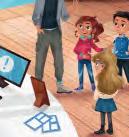
Big Picture: What can you see? Introduce
● Students say what they can see on the page.
I wonder
● Point to and read the I wonder question on page 5 aloud. Students look at the picture and answer.
1 Diagnose 0.04 Listen and find.






● Play the audio. Students point to the characters.
● Play the audio again and have students listen for who Biscuit is (a cat).
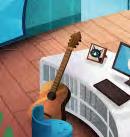
2 0.05 Listen and point. Then listen and say.
● Play the audio. Students point to the places they hear.
● Play the audio again. Ask students to repeat the words.
3 Look and say.
● Ask What color is Alicia’s hair? Have students answer (Alicia has brown hair). Write prompts on the board to help them.























● In pairs, students say something about the characters and the library.
WONDER HELPER
Introduce Daniel the Wonder helper. Read Daniel’s question and have students say what they like in the library.

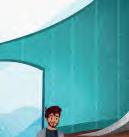

Ending the lesson
● Write five words from the picture on the board.
● Students say the places in the library these things are from.
Workbook page 2
1 Read and match. Then write. Students read the text and match. Then write the words.
ANSWER KEY: 2 e multimedia room, 3 a reading corner, 4 c gallery, 5 b courtyard
Activity 1
Audio script

Thomas Hi Daniel. Hi Alicia. Welcome to the new Rise and Shine Library!
Alicia Hi Thomas. It’s amazing!!! These are my friends. This is Rafa and this is Lena.
Thomas Nice to meet you!
Rafa Nice to meet you, too!
Thomas Welcome to the new library!
Lena I think it’s amazing.
Rafa Me, too!
Alicia Can we look around the library?
Thomas Sure, where do you want to go? The library has a study area, a multimedia room, and a gallery.
Children Wow!
Daniel I want to see Biscuit!
Rafa Biscuits? I’m hungry!
Alicia No, Biscuit is Thomas’s cat!
Rafa Oh!
Thomas Look, there’s a picture!
Learning path
Big Picture
32 F02_RS_SB3_AmE_99119.indd 7/7/21 3:19 PM
1 – Vocabulary Student Book page 4
Lesson
t
Presentation: Activities 1 and 2 t t Workbook Practice t Ending the lesson t Wonder Helper t Practice: Activity 3 Starting the lesson t
t
and say.
So rise and shine. Let’s start a fun, new day. Let’s learn and think, and play! Today and every day! I like the gallery. What do you like in the library?
Places in a library
Starting the lesson Diagnose
● Draw seven short lines on the board. Explain each line represents a letter of a word from Lesson 1. Ask the class to say letters of the alphabet to guess the word (gallery).


1 0.06 Read and sing.
● Look at the picture. Play the song and ask students to point to the places they hear.
● Play the song again and have students sing along.
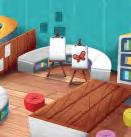
● For more confident students, play the karaoke version of the song (audio track 0.07).
2 0.08 Listen and circle true (T) or false (F).


● Play the audio. Have students look at the picture, point to the places they hear, then circle T or F.

ANSWER KEY: 1 T, 2 F, 3 F, 4 T, 5 T
3 Make sentences about the picture.

● Ask students to look at the Big Picture again. Ask the class to say what places the library has and doesn’t have.
4 Talk about your school library.
● Ask students to think about their school library or a local library. If they haven’t visited, ask them to imagine a library. In pairs, ask students to say two things their library has and two things it doesn't have.
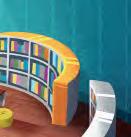
Objectives













• Lesson aim: to say what a library has and doesn’t have
• Target language: The (library) has/doesn’t have (a gallery).
















GSE











• Productive: Speaking: Can talk about everyday objects using single words, if supported by pictures. Can describe the position of objects or people in a basic way, using pictures or gestures.
• Receptive: Listening: Can understand basic phrases or sentences about things people have, if supported by pictures.
Wonder: sparking curiosity
• Write the learning objective on the board: We’re learning to say what a library has and doesn’t have.


Materials






• Audio
I can shine!
Assess
ACHIEVE The student can make complete sentences to say what the library has and doesn’t have, without extra support.
ADJUST The student can make only positive sentences saying what the library has, with some support.
EXCEED The student can give multiple examples of what the library has or doesn’t have, without support.
Ending the lesson
● Ask students to close their eyes and think about the picture. Say some places or things that are/aren’t in the library. Ask students to raise their hands to tell you if the library has or doesn’t have the thing you say.
Workbook page 2 2 Think and write. Students complete the sentences.
ANSWER KEY: 2 doesn’t have, 3 has, 4 has, 5 doesn’t have


Write. Then ask and answer. Students write, then ask and answer. Wonder helper: Students answer the question.
ANSWER KEY: In the multimedia room

Extra time: Students talk about their library.
Activity 2 Audio script

The library has an information desk.
The library doesn’t have a multimedia room.
The library has a bedroom.
The library doesn’t have a movie theater. 5 The library has a reading corner.
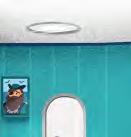
33 F02_RS_SB3_AmE_99119.indd 5
Lesson 2 – Song and structures Student Book page 5
7/7/21 3:20 PM
Wonder
3
1
2
3
t Learning path t Activities 1 and 2 t Presentation: Grammar t Practice: Activity 3 t I can shine: Activity 4 t Workbook Practice t Starting the lesson t Ending the lesson (T) or false (F). T / F 3 T / F 5 T / F 2 T / F 4 T / F the picture. library. The (library) has/doesn’t have (a gallery). It has a lot of things to do and see! The library is for you and me! The library has a gallery, It has a multimedia room, too! Let’s go to the library! It’s new! Chorus The library has a reading corner, It has an information desk, too! Let’s go to the library! It’s new! Chorus and doesn’t have. do in a library? have a gallery. The library has an information desk.
4
Objectives
• Lesson aim: to read and understand a story about a library
• Target language: computer, poster, TV, beanbag
• Recycled language: has/doesn’t have




GSE









• Receptive: Reading: Can recognize key words and basic phrases in short, simple cartoon stories.
• Receptive: Listening: Can recognize familiar words and basic phrases in short illustrated stories, if read aloud slowly and clearly.
Imagine: fostering imagination
• Encourage students to be imaginative and creative in the classroom with the unit story. Invite students to role-play the story, stepping into the characters’ shoes or telling it with their own words and gestures.
• Write the learning objective on the board: We’re learning to read and understand a story about a library.
Materials
• Audio; Story animation; Story cards; Flashcards


Starting the lesson Diagnose
● 0.07 Play the karaoke version of the song from Lesson 2 and have the students all join in.








































1 0.09 Listen, point, and say.
● Ask students to look at the pictures and have them describe what they can see.
● Play the audio. Ask students to point to the picture as they hear each item. Then play the audio again, pausing for students to repeat each word.
2 0.10 Listen or watch. What do the children find in the courtyard?
● Ask students to look at the first picture. Ask Where are the characters in the library? (the reading corner).
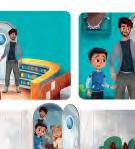
● Read the question aloud. Ask students what they think the children could find in the courtyard.
● Play the audio and ask students to follow the story in their books.
● Ask the class what the children found in the courtyard.
● Play the video.
ANSWER KEY: Biscuit, the cat.
3 Read again and circle true (T) or false (F).
● Ask the class to find the reading corner in the story. Say The reading corner has posters. True or false? Ask students to say their answer (true).
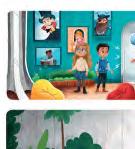
● In pairs, ask students to read the story again and circle T or F for questions 2 and 3.
ANSWER KEY: 1 T, 2 F, 3 F
4 Role-play the story.
● Have students role-play the story in small groups. Each student plays one character from the story. Play the audio and pause after each frame for students to repeat their character's lines.
I can shine!
Assess
ACHIEVE The student role-plays their character, without extra support, and adds actions that show understanding of the lines.
ADJUST The student says some of their character lines when prompted. ➔ Provide more support by building up the lines, pausing the audio after each short phrase.
EXCEED The student role-plays their character lines unprompted and can add their own ideas for extra lines.
IMAGINE HELPER
Introduce Alicia the Imagine helper to the class. Read the question aloud. Ask students to describe the courtyard in the story (old). Ask students to think of some ways to improve it.

Ending the lesson
● Play a miming game. Role-play the 4 key vocabulary items and ask students to guess which one it is, e.g., typing on a computer, watching TV, sitting on a beanbag, putting a poster on the wall. Ask volunteers to come to the front and mime for the class to guess. Workbook page 3 4 0.13 Match. Then listen, circle, and write. Students listen and circle the number of each item. Then they write the number. ANSWER KEY: 1 c 2 a 3 d 4 b a 22 twenty-two, b 30 thirty, c 4 four, d 50 fifty

34 F02_RS_SB3_AmE_99119.indd
Lesson 3 – Story Student Book page 6
Imagine Learning path t Presentation: Activity 1 t Story: Activities 2 and 3 t t Workbook Practice t Ending the lesson t I can shine: Activity 4 t Imagine Helper Starting the lesson t or false (F). The reading corner has posters. T / F 2 The library has a villain. T / F 3 Biscuit is in the multimedia room. T / F role-play a story about a library. Items in a library in there? the courtyard. the courtyard? have a villain. What’s that noise?
Objectives

• Lesson aim: to say what things places have
• Target language: Numbers 20–50; Does the (library) have (books)? Yes, it does./ No, it doesn’t.

• Recycled language: computer, beanbag, TV, books, a poster, pens
GSE











• Receptive: Listening: Can recognize ordinal numbers up to 50, if spoken slowly and clearly. Can understand simple questions and answers about people’s likes and dislikes.



• Productive: Speaking: Can ask and answer simple questions about things people have.















Build: building confidence

• Build confidence in English through whole-class speaking and repetition of key words/blocks in target structure, and finding similar words on the page.

• Write the learning objective on the board: We’re learning to say what things places have.




Materials









• Audio

Starting the lesson Diagnose
● Ask Are there books in the library? (yes), What other things are in the library? Elicit some ideas and write or draw them on the board.

1 0.11 Listen and count. Then say the missing numbers and write.
● Ask students to look at the picture. Ask What is on the books? (numbers). Ask students to listen for what numbers are missing.
● Play the audio. Have students count along with the recording and point to the numbers.

● Ask students which numbers are missing. Students then write the numbers.
ANSWER KEY: 22 twenty-two, 27 twentyseven, 31 thirty-one, 38 thirty-eight, 43 forty-three, 45 forty-five, 49 forty-nine



































2 Play the game.
● Have students play the game in pairs. Ask one student to say the number, and for their partner to write it down in numbers and words. If a student writes the number down correctly, they get a point. Switch over.
3 0.12 Listen and read. Then chant.
● Point to the Grammar builder. Ask Does the reading corner have books? (yes). Explain we can say Yes, it does. Ask Does the multimedia room have books? (no). Explain we can say No, it doesn’t
● Play the audio.
● Play the track again, pausing after each line for students to repeat.
BUILD HELPER


Point to Lena, the Build helper. Ask the question Does the library have computers? and elicit answers from students.
4 Ask and answer.
● Point to realia in the classroom and ask questions, e.g., Does the classroom have books? (Yes, it does.), Does the classroom have a cat? (No, it doesn’t.).
● In pairs, encourage students to take turns asking and answering questions about different areas in the Rise and Shine library. I


Assess
ACHIEVE The student asks and answers questions and uses the correct short answer form, without support.











ADJUST The student asks some questions about what is in the library, with support, and gives simple Yes/No answers.
EXCEED The student asks and answers questions. In addition, they give extra information, e.g., Yes, it does. It has one computer.
Ending the lesson
● Give each student a piece of paper. Ask them to draw an object they know.
● In small groups, students take it in turns to show their pictures to the group. The student showing their picture asks Does the classroom have… ? and their item. The group looks around and answers.
Activity 3
Lena Come on everybody, listen to me. Does the reading corner have books? Boy Yes, it does!
Lena Does the multimedia room have books? Boy No, it doesn’t.
Audio script
Lena Come on everybody, chant with me. Children Does the reading corner have books? Yes, it does. Does the multimedia room have books? No, it doesn’t.
35 F02_RS_SB3_AmE_99119.indd 7
4
Student Book page 7
Lesson
- Vocabulary and structures
Build t Learning path t Presentation: Activity 1 t Activities 2 and 3 t I can shine: Activity 4 t Workbook Practice t Starting the lesson t Ending the lesson t Build Helper
can shine!
Numbers 20–50; Does the (library) have (books)? Yes, it does./No, it doesn’t. have. Does the multimedia room have No, it doesn’t. have computers?
Objectives
• Lesson aim: to tell the time
• Speaking function: to ask and answer about the time



• Functional language: What time is it? It’s (one o’clock)/(one)-thirty.


GSE














• Receptive: Listening: Can understand the time of day when expressed to the half hour.

• Productive: Speaking: Can tell the time of day to the closest half hour. Can answer simple questions about things they have, in a basic way. Can ask simple questions about other people.









Grow: nurturing growth in society








• Encourage students to think about why it is important that they can tell the time. Telling the time means they can manage their own time and be on time for school.


• Write the learning objective on the board: We’re learning to tell the time. Materials

• Audio
Starting the lesson Diagnose
● Draw a clock face on the board. Tell the class At 11 o’clock, I go to the cafe. Draw 11 o’clock on the board.


● In pairs, students draw 3 clock faces. Tell them 3 times and have students draw the times.












1 0.14 Listen and write the times. Then ask and answer.
● Ask the class to point to the clock that shows 11 o’clock.
● Play the audio and have students number the clocks in their notebooks. Then play the audio track again. Have them point to the clocks and say the time.
● Then put students into pairs to ask and answer.
ANSWER KEY: a It’s twelve-thirty., b It’s three o’clock., c It’s five-thirty., d It’s eleven o’clock.





2 0.15 Say the activities they can do. Then listen and check (✓).
● Draw students’ attention to the Library Activity Day flyer. Ask How many activities are there? (6).
● Read the speech bubbles and have students think about what activities the children can do.
● Play the audio and ask students to point to the times and activities they hear. Then play the audio again and have students say the activities.
ANSWER KEY: 1 painting, 2 story time

GROW
HELPER
Introduce Thomas the Grow helper to the class. Have students say which activity they want to do.
3 Tell a friend about an activity you do.
● Ask the class to say some activities they like to do after school. Ask When do you do this activity? What day?
● Put students into pairs and have them tell their partner about an activity they like to do.
Assess
ACHIEVE The student recognizes and says what they like to do, at what time, and where.
ADJUST The student says an activity they do, with support.
EXCEED The student asks what time it is and discusses what activities they do at different times of day.
Ending the lesson
● Draw an empty clock face on the board. Put students into small groups. Draw a time and have groups say the time.

Workbook page 3
5 Read and draw. Students read and draw the clocks.
Activity 1
1 Boy What time is it?
Girl It’s eleven o’clock.
2Girl What time is it? Boy It’s five-thirty.
Activity 2
1 Girl What time is it?
Man It’s nine-thirty.
Audio script

3 Boy What time is it?
Girl It’s twelve-thirty.
4Girl What time is it? Boy It’s three o’clock.
Girl Great, let’s go to painting.
2 Boy What time is it?
Woman It’s three o’clock. Boy Great, let’s go to story time.
36 F02_RS_SB3_AmE_99119.indd 8
I can shine!
Lesson 5 – Communication Student Book page 8 Grow
Learning path t Presentation: Activity 1 t Practice: Activity 2 t t Workbook Practice t Ending the lesson t I can shine: Activity 3 t Grow Helper Starting the lesson t Telling the time. ✓). 9:30 10:30 12:00 1:30 3:00 Welcome! Painting animals. adventure movie. sandwiches. with your friends. favorite books.
Objectives














• Lesson aim: to review what we’ve learned in the unit and to make a library record
• Reviewed language: reading corner, multimedia room, books, beanbags, clock, (ten)-thirty, (three) o’clock, posters, computers, TV


GSE









• Receptive: Listening: Can recognize familiar key words and phrases in short, basic descriptions, if spoken slowly and clearly.


• Productive: Speaking: Can talk about everyday objects using single words, if supported by pictures. Can describe the position of objects or people in a basic way, using pictures or gestures.
Shine: Time to shine!
• Encourage students to use as much language from the unit as they can and to ask a partner for support when making the library record, if they need to.

• Write the learning objective on the board: We’re reviewing what we’ve learned in the unit and we’re making a library record.
Materials



• Coloring pencils, colored paper, card or paper







Starting the lesson Diagnose
● Show students some images of different areas in the library and ask students to say what they can see. Encourage them to say rooms, objects, and colors and give ideas using has
















































































Step 1: Review




1 Describe the pictures. Then ask and answer.

● Draw students’ attention to the pictures and the speech bubbles. In pairs, ask them to say and ask and answer with their partner about what they can see. Write It has and It doesn’t have and the question Does it have… ? on the board to prompt them.
Step 2: Create

2 Draw a cover for your library record.
● Write library record on the board. Explain to students that they are going to make a small book to write down what they learn in each unit. Tell them they can record (write down) their favorite words, songs, and stories. They will keep it and add to it as they learn more.
● To make the library record, fold a piece of lettersize paper in half. Open the paper and divide the page into six equal sections, one for each unit.

● On the cover, students draw their favorite place in the library with some of the objects from this unit. Ask them to use the Big Picture from Lesson 1 or the objects from Lesson 3 to help them.
● In the Time to Shine in every Review lesson, students will complete the sections of their library record.
3 Ask and answer.
● Read the speech bubbles to the class. Put students into pairs and explain they need to ask their partner questions to find out what their library record cover has or doesn’t have.
Time to shine!
4 Present your library record to the class.
● Explain they are going to share their library records with the class.
● Have each student show and explain their library record to a small group or to the class. Encourage them to use This is… It has… It doesn’t have.

Time to shine!
Assess
ACHIEVE The student says full sentences, both positive and negative, about their library record.
ADJUST The student talks about their library record in a simple way, with support.


EXCEED The student can add additional information about the library record, e.g., There are beanbags. They are blue.
Ending the lesson
● Play a memory game. Choose one of the library records from the students and show it to the class. Give them 30 seconds to look at it and remember the picture. Then ask the class to say the things they can remember from the picture.
Workbook page 3
6 Imagine your perfect library. Think and complete. Students choose what’s in their perfect library, using the words from the Welcome Unit.
Extra time? Students tell their family about their perfect library.
37 F02_RS_SB3_AmE_99119.indd 9
Shine Lesson 6 – Our library records Student Book page 9 t Learning path t Review: Activity 1 t Project: Activities 2 and 3 t Time to shine: Activity 4 t Workbook Practice t Starting the lesson t Ending the lesson A library record to the class. library record.


















































































































 Alicia
Daniel Thomas Rafa Lena
Alicia
Daniel Thomas Rafa Lena












































































































































































































































































































































































































































































































































